|
Posted 10/20/22
WORLDS APART…NOT!
Violence-wise, poor neighborhoods in Oakland and Houston aren’t so different

For Police Issues by Julius (Jay) Wachtel. Oakland Police Chief LeRonne L. Armstrong’s September 27 news release was seriously disquieting. “In the midst of the deadliest week this year with eight lives lost” he announced a major effort to deploy “all available resources” to fight the gun violence that threatened to consume his community. While the good Chief didn’t mention it, only a week had passed since a shooting just outside City Hall claimed the fourth death by gunfire in less than a day. And what the Chief couldn’t know was that on September 28 – one day after his comments – two shooters would open fire inside a local high school complex, wounding six including a security guard, in what the beset city has called a gang-related attack.
We posted an update about the school shooting on the twenty-ninth. But what we couldn’t predict was that on the same day the Department of Justice would issue an elaborate news release announcing a “surge of resources” to combat violence in Houston.
Click here for the complete collection of crime & punishment essays
Houston?
In law enforcement circles, and likely elsewhere, Oakland’s long carried a reputation for being a dangerous place. Not so much America’s famed “Space City”. Boasting nearly two and one-half million residents, the home of each U.S. person-on-the-moon mission ranks fourth, population-wise, behind New York City, Los Angeles and Chicago. And other than for occasional slap-downs over the behavior of its cops (see, for example, “Before Jet Blue”) it’s mostly figured in our essays as the place where George Floyd earned his criminal stripes before relocating to Minneapolis.
Our bad. After reading about the AG’s intentions, we looked up Houston’s crime numbers. And while they’re not quite “up” to Oakland’s level, they’re also quite bad. Here’s a comparo that includes New York City, L.A. and Chicago as well:
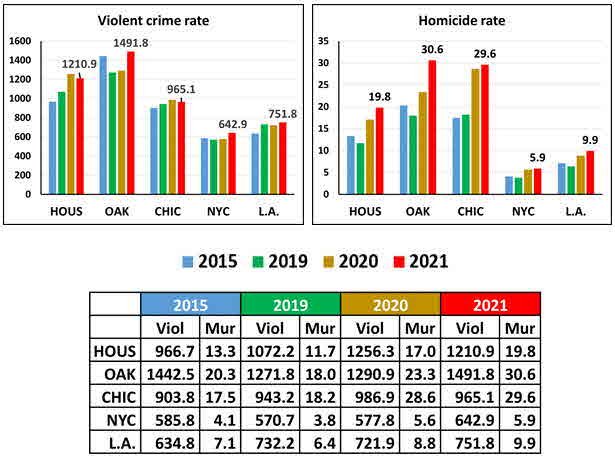
(2015 and 2019 data is from the UCR. 2020 data is from the NIBRS. 2021 data for Houston is from the NIBRS. 2021 data for the other cities is from their sites. Click here for LAPD, here for NYPD, here for Chicago, and here for Oakland).
Full stop. Municipal boundaries are artificial constructs. People live in neighborhoods. And as we’ve often reported, residents of economically better-off places endure less violence – often, far less – than their deprived cousins. Consider, say, New York City. Despite recent surges in violence, the crime rates that former Mayor Bloomberg used to brag about remain, comparatively speaking, a marvel. But even in the Big Apple, violence and affluence are undeniably linked. Here, for example, is the somewhat dated comparo in “Be Careful What You Brag About (Part II)”:
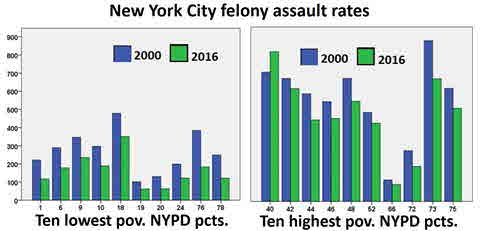
Our data forays indicate that neighborhood poverty continues to exert its unholy influence, in New York City and elsewhere:
- “What’s up? Violence” set out homicide, aggravated assault and robbery rates per 100,000 pop. For New York City’s wealthy Upper East Side (pop. 220,000) and its downtrodden Brownsville/Ocean Hill area (pop. 86,000).

- It’s not just New York City. Here we use data from “What’s Up?” to compare LAPD’s advantaged West L.A. area (pop. 228,000) with the city’s chronically poor 77th. Street district (pop. 175,000):

- Data from Chicago PD’s 2021 Annual Report and the city’s community poverty level report was used to compare homicide, violent crime and poverty rates between CPD’s 20th. District (its primary constituent neighborhood is Lincoln Park, pop. 70,492, pov. 12.3%) and its 7th. District, which serves the chronically troubled Englewood area (pop. 24,369, pov. 46.6%). These are rates, so they're directly comparable. Once again, poverty’s influence seems indisputable:

Houston
So what about our new places of interest? Do neighborhood economic conditions exert a like influence on the personal safety of Houston’s inhabitants? There’s been a “tweak” in our approach. We’ve grown fond of the Census’ ability to specify income and poverty by ZIP. Houston has ninety-six ZIP codes. Eliminating those that are clearly non-residential or include adjacent cities, we wound up with eighty-five. Turning to the Census, we recorded each Zip’s percent of residents in poverty (i.e., “below 100 percent of the poverty level”).
Houston PD’s crime data portal provides a street address for each crime incident, and the ZIP codes of most. Filling in those that were missing, we coded full-year 2021 data for aggravated assaults, robberies and murders (not simply “homicides,” but unlawful, intentional killings.)

Do Houston’s neighborhoods experience a connection between economic conditions and violence? According to our scattergrams – each dot is a Zip – the answer seems “yes”. As Zip’s get poorer, murder and violent crime rates consistently increase. While the relationship isn’t perfect – some poor places had no murders – the correlations are substantial.
Searching for another way to visualize the relationship, we fell back on our earlier effort in “Don’t Divest – Invest!”, which contrasted Portland’s ten most “peaceful” neighborhoods with the ten most racked by crime and violence. This table, which sets out Zip codes in order of poverty, compares Houston’s five wealthiest Zip’s with the five most disadvantaged:
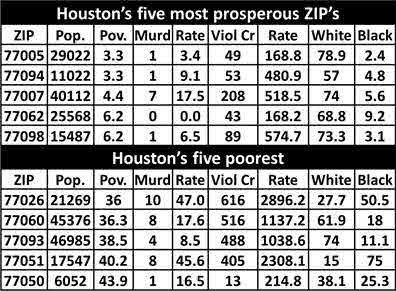
“Disadvantage” clearly carries some violent baggage. While the uncertainties of data (and the vagaries of human nature) create exceptions, the trend is nonetheless clear: more bucks, less violence. In addition to rates, which are comparable across jurisdictions, we also included actual murder and violent crime counts. Proportion of White and Black residents is from the Census. Its 2021 estimates indicate that about thirty percent of Houston’s residents are White and about twenty-two percent are Black. Note that the latter are substantially under-represented in the most prosperous Zip’s. And that under-representation carries some potentially lethal baggage. According to DOJ’s just-released national criminal victimization data for 2021, Black persons endure a substantially higher rate of serious violent victimization (7.4 per 1,000) than either Whites or Hispanics (each was 5.4).
Oakland
 Oakland’s crime data includes street address but not Zip codes. Limiting events to those classified as “murder”, we entered the address of each incident into Google for the Zip. Oakland has thirteen regular Zip’s. Excluding one murder in a Zip it shares with another city, it reported 100 murders in 2021. (We ignored two dozen “homicides” not classified as murders.) Oakland’s crime data includes street address but not Zip codes. Limiting events to those classified as “murder”, we entered the address of each incident into Google for the Zip. Oakland has thirteen regular Zip’s. Excluding one murder in a Zip it shares with another city, it reported 100 murders in 2021. (We ignored two dozen “homicides” not classified as murders.)
Here’s the scattergram. As in Houston, each dot is a Zip. Although Oakland’s number of “cases” is limited, the relationship between poverty and murder seems well supported. That connection, as well as the disadvantage suffered by Black persons, is evident in a five wealthiest/five poorest comparo (again, Zip’s are in order of poverty):

So what’s the takeaway? Houston and Oakland follow the same pattern that we’ve repeatedly observed within cities. “Don’t “Divest” – Invest!” examined twenty Portland neighborhoods. Its “ten most/least peaceful” comparo essentially duplicates our findings here, and literally everywhere else we’ve looked. And it’s not just “within” cities. That same pattern: more poverty, more crime is also evident in between-city comparisons. Check out “But is it Really Satan?”, which looked at poverty and crime in twenty-one Louisiana cities.
Be sure to check out our homepage and sign up for our newsletter
Fine, you say, but what to do? No matter how well done, policing cannot itself “fix” neighborhoods. To be sure, attempts to do so continue. Some are couched under the umbrella of DOJ’s “Project Safe Neighborhoods.” To its credit, that well-known strategy’s current incarnation goes beyond tough-nosed enforcement. It now articulates a need for “fostering trust and legitimacy in our communities, supporting community-based organizations that help prevent violence from occurring in the first place.”
Yet cops can’t defeat poverty. For that conundrum we turn to the Urban Institute. Its landmark study, “Tackling Persistent Poverty in Distressed Urban Neighborhoods,” offers a splendid approach for developing and instituting “place-conscious strategies” that can rebuild the human infrastructure. Their bucketful of to-do’s, which we discussed in “Mission Impossible?” includes educational opportunities, job training and apprenticeships, summer jobs for youth, transportation, child care, and physical and mental health resources. And yes, safety is important. So police do have a role to play. But the solution clearly calls for a lot more than policing.
UPDATES (scroll)
11/7/24 Elected officials in the “Bluest” of areas may have met their match. Progressive
Los Angeles D.A. George Gascon, who was blasted by his staff for going easy on the accused and hard on cops, was ousted by former Federal
prosecutor Nathan Hochman, who blamed his rival for the waves of theft and misbehavior that haunt L.A. And in California’s violence- and
homelessness-beset Bay Area, voters booted two other progressives: Oakland Mayor Sheng Thao and Alameda County D.A. Pamela Price. Their
preference for pulling back the throttle on policing and punishment seems no longer in favor.
10/17/24 In a case brought by four weary San Francisco residents, a Federal judge ruled that they can indeed sue the city for “actively contributing” to problems in the beset Tenderloin area by, among other things, distributing supplies that ostensibly help street people “safely” use drugs. Thus, encouraging their presence. And in nearby Oakland, crime and homelessness have led to a forthcoming recall vote of the Mayor and D.A., whose go-easy law-enforcement approach has supposedly encouraged misbehavior.
8/1/24 A mass shooting recently left fifteen residents wounded. And while murder is somewhat down, robberies are up, and businesses large and small are fleeing the city. To top it off, Mayor Sheng Thao’s home was recently raided by the FBI as it investigates influence-buying by city contractors. Voters upset over Oakland’s struggles with poverty and crime will soon decide whether to recall the D.A. and the Mayor. A “Blue” political consultant calls it a perfect storm. “For the city, I can’t think of a tougher time.”
7/29/24 Oakland city policy limits police pursuits to circumstances “when there is reasonable suspicion to believe the fleeing individual committed a violent forcible crime and/or a crime involving the use of a firearm, or probable cause that the individual is in possession of a firearm.” Calif. Gov. Gavin Newsom claims these rules encumber officers’ ability to respond to a host of crimes and encourages criminals to flee. In contrast, CHP officers assigned to help the crime-beset community frequently chase and arrest offenders, recover numerous stolen vehicles and seize many guns.
6/21/24 A large number of all-terrain vehicles and motorcycles roared into a seemingly peaceful Juneteenth gathering of several thousand at Oakland’s Lake Merritt. Their sideshow quickly morphed into a shootout that left fifteen persons ages 20-30 wounded, at least one critically. Dozens of shell casings were recovered, but no arrests have yet been made. A shootout took place at the same celebration in 2021, fatally wounding a 22-year old San Francisco man.
5/9/24 Concerns that Houston police shut down thousands of investigations because of insufficient resources apparently prompted Chief Troy Finner’s sudden retirement. In February he announced that 4,000-plus inactive sexual assault cases were being re-examined. Most were soon closed, but eighty with DNA hits remain open. It’s not a recent problem, or only with sex assaults. In 2018, before he was Chief, he had blamed “lack of personnel” for ignoring a “road rage report”. But the Mayor said that the issue had become overly distracting, and he agreed it was time for the Chief to leave.
4/1/24 California is funding the deployment of 480 specialized surveillance cameras in and around crime-beset Oakland. They can capture and store a host of information about vehicles beyond license plates, and are programmed to inform authorities, in “real time,” when a vehicle whose features resemble those of a wanted car is spotted. But civil rights advocates criticize the move as spending money that could be better used to help support needy residents.
3/15/24 Going against a seeming trend, Oakland crime “surged” in 2023. Traditionally violence-ridden areas got worse, and even privileged districts became beset with break-ins. In response, both Denny’s and In-N-Out Burger simply closed shop. Local politicians blame the “crime wave” on inadequate police funding and “reforms” such as Prop. 47 that substantially eased punishment. Memories of police misconduct haunt the search for solutions. But after having his car repeatedly broken into, even a police reform advocate wonders “what is going on?”.
2/7/24 Oakland’s marked increase in violent crime and theft, which seem badly out of synch with other cities, has upset the local NAACP chapter. It urges tougher measures to protect vulnerable minority communities. “If there are no consequences for committing crime in Oakland, crime will continue to soar.” To help, Calif. Governor Kevin Newsom is sending 120 CHP officers. But he resists tinkering with the much-maligned Proposition 47, which eased criminal penalties. Some now blame that for more crime.
1/26/24 In-N-Out is definitely “out” - of Oakland, that is. In seventy-five years the popular burger chain had never closed a location. But according to its COO, patrons of its Oakland restaurant have been frequently falling victim to “car break-ins, property damage, theft and armed robberies.” In one such incident drive-through customers were methodically robbed at gunpoint. Similar episodes have beset a nearby gas station. Violent crime in Oakland reportedly increased 21% in 2023. And it’s still up.
12/4/23 Citywide, Chicago homicide is down 12 percent so far this year, from 644 to 569 thru November 26. But the Chicago Tribune isn’t celebrating. According to its analysis, the gain reflects improvements in the city’s traditionally peaceful areas. Say, Rogers Park (CPD Dist. 24), where homicides dropped 21%, from 14 to 11. But the city’s notoriously violent areas have remained so. For example, murders in Englewood (CPD Dist. 7) increased from 51 to 55. That’s 8 percent worse.
8/2/23 Armed robbers shot and critically wounded a Chicago postal carrier as he delivered mail on Chicago’s northwest side. Mail carriers have been beset for at least a year by armed robbers “stealing packages, letters and master keys that open clusters of mailboxes”, and a union official recently said that his members are frightened “and some don’t even want to return back to work.”
4/5/23 Elected by a slim margin, Brandon Johnson, Chicago’s progressive new Mayor, faces the city’s seemingly intractable problem of gun violence, with murder counts exceeding more populous Los Angeles and New York City. Johnson has “walked back” promises to cut police. But his plans to replace vacant officer slots with community workers, to increase detectives by cutting patrol, and to remove Shot Spotter gunfire detectors because they can cause dangerous encounters remain on the table.
2/17/23 Oakland’s mayor fired police chief LeRonne Armstrong after an outside report, commissioned by the city, concluded that the chief repeatedly failed to discipline his officers. In one example, a sergeant escaped punishment for a 2021 hit-and-run and, in 2022, discharging his gun inside an elevator. Ex-chief Armstrong, who has been on administrative leave for a month, has vigorously contested the findings.
1/25/23 More lethal gunplay rocked the nation. Jarid Haddock, a 21-year old Yakima man, used a pistol to “randomly” shoot and kill three strangers in and near a convenience store on Tuesday. He later committed suicide. Haddock was once arrested for stealing a car. After some difficulties with drug use, he completed a diversion program and charges were dismissed. And in Oakland, gunfire erupted during the Monday evening filming of a music video at a gas station. A hail of nineteen bullets left one person dead and four wounded. Gang rivalries are blamed, and so far no one has been arrested.
1/23/23 In Oakland, Calif., a scathing report by a law firm hired by the city to investigate two egregious episodes of officer misbehavior, one in 2021 and another last year, concluded that Police Chief LeRonne Armstrong, who was appointed in 2021, had essentially whitewashed both events. So he’s been placed on “administrative leave.” Oakland P.D. has been under a court order to tighten officer oversight since a group of cops known as the “Riders” ran roughshod in the community.
11/4/22 With “a really deadly September” marked by seventeen homicides, and 105 murders so far this year, Oakland Police Chief LeRonne Armstrong implemented an “aggressive” plan that focused “on those [individuals] that were driving gun violence.” He claims that its initial thirty days brought on substantial reductions in shootings and homicide, and the program is being extended for another month. But skepticism abounds, with one activist describing police-community relations as “horrific”.
10/24/22 Could $500 a month for two years help keep employed but struggling persons housed? That’s what 3,250 residents of Cook County (Chicago) are about to find out. The program, which is open to individuals and families whose household income does not exceed 250% of the Federal poverty level, has already had 184,000 applicants. Payments will begin in December. Cook County website
|
Did you enjoy this post? Be sure to explore the homepage and topical index!
Home Top Permalink Print/Save Feedback
RELATED POSTS
Neighborhoods special topic
“Legal” Gun Buyers Can be a Problem Fearful, Angry, Fuzzy-headed. And Armed.
Massacres, in Slow-Mo Hard Times in “The Big Easy” What’s Up? Violence
Don’t “Divest” – Invest! But is it Really Satan? Mission Impossible?
Be Careful What You Brag About (II) Before Jet Blue
Posted 9/27/22
HARD TIMES IN “THE BIG EASY”
In New Orleans, poverty and crime go together like, well…

For Police Issues by Julius (Jay) Wachtel. Louisiana’s largest city occasionally draws our attention over the behavior of its cops (click here and here). As former mayor Mitch Landrieu noted when the Justice Department stepped in over a decade ago, “I have inherited a police force that has been described by many as one of the worst police departments in the country.” DOJ soon issued a massive report that upbraided officers for making unwarranted stops and arrests, using excessive force, and demonstrating bias against women and minorities. Managers weren’t ignored. They drew considerable scorn for a preoccupation with numbers, which “diverts attention and resources from quality arrests, community engagement, and more considered problem-solving.” In 2018 the city entered into an elaborate consent decree that required NOPD fundamentally change its way of doing business, both within and on the streets.
We’ve cautioned about the consequences of pushing numerical productivity. Indeed, Police Issues has a special section on “Quantity and Quality.” So was that the cause of NOPD’s alleged dysfunction? Or is something more fundamental at work? DOJ’s slap-down offered an intriguing clue:
Some argue that, given the difficulty of police work, officers must at times police harshly and bend the rules when a community is confronted with seemingly intransigent high levels of crime. Policing is undeniably difficult; however, experience and study in the policing field have made it clear that bending the rules and ignoring the Constitution makes effective policing much more challenging.
Click here for the complete collection of crime & punishment essays
As it turns out, those “intransigent” levels of crime have beset The Big Easy for a very long time. Unfortunately, our recent probe of Louisiana (“But is it Really Satan?”) altogether ignored the State’s largest city. So imagine our despair when we recently came across the Wall Street Journal’s splendid (and deeply sobering) piece, “New Orleans Has America’s No. 1 Murder Rate. ‘We’re in a Crisis.’” Based on data recently published by the Major Chiefs Association, it reports that New Orleans’ homicide rates aren’t just in the pits – they’re the worst in the land!
We decided to check for ourselves. MCCA published violent crime numbers for the first six months of 2021 and 2022 for seventy major U.S. cities and metro areas. Using 2021 population estimates from the Census (click here and here) we computed homicide rates (per 100,000 pop.) for every place surveyed by the Chiefs. And the results definitely bear out the Journal’s despair. On the left are the most murder-ridden areas, rate-wise. On the right is a comparo between the nation’s murder capital (New Orleans) and five major cities that frequently appear in our posts. Really, if being worst counts, The Big Easy “easily” earns the trophy.
 |
Full stop. For the past decade, essays in our Neighborhoods special topic have warned that results of such comparisons may not be as meaningful as one assumes. After all, cities are artificial constructs. New York City brags about its safety. According to the table, its homicide rate does seem benign. But as we pointed out in “Fix Those Neighborhoods”, the Big Apple’s peaceful character doesn’t extend to its poorer districts. Say, Brownsville (pop. 86,000), which sports a deplorable murder rate of 29.1.
We don’t look on economic conditions as the ultimate cause of violence. Poverty rates, though, seem to function as a surrogate for an unholy alliance of factors (e.g., unemployment, lack of child care, ill-behaved peers) that can collectively make life miserable. And get folks killed. So instead of simply wagging our finger at The Big Easy, let’s look within. Our main source, New Orleans P.D.’s “Electronic Police Report 2022” provides basic information on “all Police Reports filed by NOPD officers”. To align our results with the Major Chiefs data, we focused on the first six months of 2022, from January 1 through June 30, selecting every entry coded as “HOMICIDE” and where victim status was “FATAL.”
That process yielded 101 homicide victims. For step 2 – where in New Orleans? – we queried the incidents’ street locations in Google. That yielded sixteen ZIP codes (the city has nineteen principal ZIP’s, but three – 70121, 70123 and 70124 – had no homicides during our timeframe.) We then turned to the Census and gathered 2019 ACS estimates for each ZIP’s population and percent in poverty: cumulative, “White alone” and “Black or African American alone.” (And yes, we share. Click here for the data.)
Our first order of business was to look for a 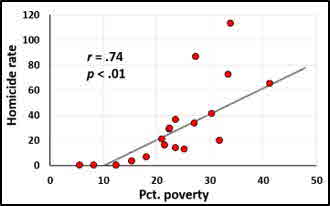 relationship between ZIP code poverty percentages and murder rates (per 100,000 pop.) As our graph indicates, their correlation was in the expected direction (more poverty, more murder) and very robust. In fact, the “r” statistic of .74 turned out to be virtually identical to the .73 “r” yielded by our 2021 comparison of poverty and violence rates for New York City’s 59 Districts (“Woke up, America!”). relationship between ZIP code poverty percentages and murder rates (per 100,000 pop.) As our graph indicates, their correlation was in the expected direction (more poverty, more murder) and very robust. In fact, the “r” statistic of .74 turned out to be virtually identical to the .73 “r” yielded by our 2021 comparison of poverty and violence rates for New York City’s 59 Districts (“Woke up, America!”).
And just like in New York City (and everywhere else we’ve ever looked) the consequences fell hardest on the racial and ethnic groups that disproportionately inhabit the city’s poorer areas. According to the Census, New Orleans’ population of 376,971 is 33.4 pct. White and 59.2 pct. Black. Overall poverty is 24.8 pct., with Black poverty (33.2 pct.) nearly three times that of Whites (12 pct.) Check out these graphs, which arrange New Orleans’ nineteen regular Zip codes by percent of residents in poverty, with the wealthiest Zip (5.6 pct. poor) on the left and the most economically deprived (41.3 pct. poor) on the right:
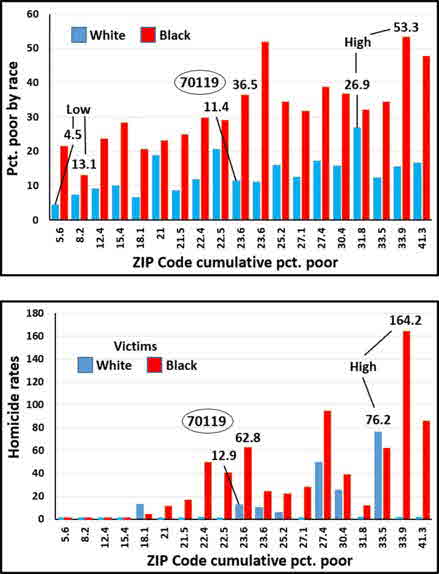

Black residents are doubly disadvantaged. As ZIP Code poverty rates worsen, their share of the population (top graph) and rate of homicide victimization (bottom graph) substantially increase. Consider, for example, Zip 70119, with a mid-ranked 23.6 pct. cumulative poverty score. Although it has about the same number of White and Black residents, the latter were three times more likely to be poor and five times more likely to be murdered.
Be sure to check out our homepage and sign up for our newsletter
So are economics entirely to blame for New Orleans’ travails? Maybe not. According to the Wall Street Journal, and to a recent article in The Lens, the consent decree, and the elaborate internal controls it produced, led many cops to leave. It’s also reportedly hampered recruitment, which is in the dumps across the U.S. Specialized NOPD units were stripped to augment depleted patrol ranks, and 9-1-1 responses are interminably delayed. So much so, that many citizens and businesses have taken up arms. Or simply left. Meanwhile the Federal judge overseeing the consent decree announced that, contrary to her recent suggestion, the end is not exactly in sight. According to U.S. District Judge Susie Morgan, problems with “crime reporting data, calls for service and response time” require an “innovative” response. Given NOPD’s severe staffing shortage, though, that definitely seems a stretch.
But maybe not. Perhaps that coach-person can pull out a solution from their top hat. So we’ll see.
UPDATES (scroll)
12/10/24 On July 4th. Louisiana enacted a law allowing permitless concealed gun carry. Minimum age is 21. New Orleans officials are now upset about a surge of shootings, which most recently left two adults and a child dead and injured six during a single-day span. Violence is reportedly otherwise down, and observers comment that ill-intending persons will get guns one way or another. According to a business owner, “We haven’t seen where innocent people who are allowed to carry weapons are involved in things that are illegal. If somebody chooses to go out and commit an act of violence, it's going to be hard to stop that no matter what city you’re in.”
11/19/24 On Sunday, November 17, an annual New Orleans parade and celebration sponsored by the Nine Times Social Aid & Pleasure Club was marred by two episodes of gunfire. In the first incident, at about 3:30 p.m., nine persons were wounded in the St. Roch neighborhood, near the French Quarter. One-half hour later, two persons were killed and one was wounded at the Almonaster Avenue Bridge, about a half-mile away. No arrests have yet been made.
9/3/24 Elected in 2020 on a platform of correcting “the sins of the past,” Jason Williams, New Orleans’ progressive D.A., has had “more than 140” convictions thrown out and obtained sentence reductions for “at least 180” accused. His civil rights division focuses on past convictions that were supposedly marred by constitutional issues or unjust legal practices. But an advocacy group, “Bayou Mama Bears”, warns that his actions have endangered public safety and benefited violent criminals.
7/18/24 Conducted throughout June, “Operation Clean House” was a month-long effort by teams of Federal, State and local officers to reclaim New Orleans’ violence-impacted neighborhoods. In Phase I, proactive, “intelligence-driven actions” by law enforcement teams led to 74 arrests and the seizure of large quantities of drugs and firearms, including “AK-47s, AR-15s, Glock switches, and multiple types of handguns.” Phase II, which focused on apprehending fugitives charged with violent crimes, resulted in 76 arrests for offenses ranging from aggravated assault to drive-by shootings and murder.
10/23/23 Federal-local task forces used information from crime gun recoveries to target firearms and drug distribution networks in violence-beset Memphis and New Orleans. During both summer-long operations, many stolen firearms, guns with illegal “machinegun conversion” switches and weapons without serial numbers were seized. In Memphis, twenty-one defendants face Federal charges of illegal gun possession, unlicensed gun dealing, and drug trafficking. In New Orleans, forty-one have been charged with similar offenses in Federal and State Courts.
5/15/23 A New Orleans clergyman who’s “lost count of funerals” wears a bullet-resistant garment under his robe and packs a gun. With shootouts erupting near his parish, Pastor Isaiah Stewart teaches members of his flock how to shoot. “This is our reality. A lot of times, it feels like you’re on your own.”
1/9/23 New Orleans’ Mardi Gras season runs from January 6th. until “Fat Tuesday”: this year, that’s Feb. 21st. It’s a time for parties, balls and parades. But worries about the city’s skyrocketing crime rate and a police force short hundreds of cops has put a cloud over the festivities. Officials have promised to pay for outside cops to come in, and there’s hope of avoiding a repeat of last year’s toned-down event.
10/20/22 A 1994 drive-by murder at a New Orleans housing project resulted in the imprisonment of two 17-year olds and an 18-year old. Then-cops Len Davis and Sammie Williams, who were taking bribes from drug dealers, got a local man to testify, and the youths, who insisted they were innocent, were convicted. But key evidence wasn’t turned over. All that, plus the fact that former officer Davis faces a death sentence for an unrelated murder, has just led to the youth’s release and exoneration.
10/11/22 NIJ’s brand-new release, “Criminal Victimization, 2021,” reports a profound decline in the rate of violent victimization since the early nineties. However, urban areas experienced a significant uptick during 2020-2021. Persons in lower-income brackets were by far the most affected. For example, in 2021 residents at the bottom of the earnings scale suffered violent crime victimization rates of 29.6 per 1,000, while the rates for the wealthiest was a far lower 9.7.
9/29/22 Six adults were wounded - two, critically - by gunfire at an Oakland school complex. Two were reportedly carpenters who got caught up in “crossfire.” Oakland’s severe violence problem - it’s reported 93 homicides so far in 2022, with eight in the past week - led Police Chief LeRonne Armstrong to declare “we are going all-hands-on-deck to address the gun violence in the city of Oakland.” He promised more investigators and increased deployment in areas dominated by gangs. But activists insist that the violence is caused by “poverty and disinvestment,” and that more cops are not the solution.
|
Did you enjoy this post? Be sure to explore the homepage and topical index!
Home Top Permalink Print/Save Feedback
RELATED POSTS
Neighborhoods special topic Craft of Policing special topic
See No Evil - Hear No Evil Worlds Apart...Not! “Woke up,” America! Fix Those Neighborhoods!
De-escalation Before JetBlue
Posted 5/13/22
WHEN DOES EVIDENCE SUFFICE?
Jurors may be more likely to give circumstances their due
For Police Issues by Julius (Jay) Wachtel. Billy Kipkorir Chemirmir. That name – and assumedly, its bearer – will surely go down in infamy. A 49-year old Texas man, he has been indicted for killing eighteen elderly women (and is presumed to have murdered many more) during a years-long homicidal spree at senior living facilities in Dallas and its suburbs. Chermimir gained access by pretending to be a caregiver or maintenance worker. And when he discovered there was jewelry to steal, he suffocated his victims – each was in their eighties or nineties – and sold their valuables. Chermimir used pillows, and given the absence of obvious trauma and his victims’ advanced age, the deaths were initially attributed to natural causes. Indeed, until one of his targets survived and called for help, no one suspected that a serial killer of the elderly was on the loose.
 Chemirmir wasn’t totally unknown to the criminal justice system. An immigrant from Kenya – he arrived as an adult in 2003 – he would in time rack up a couple of DUI’s and, in 2012, an arrest for domestic violence. His next legal tangle, though, turned out far more significant. In June, 2016 Chemirmir was arrested for trespassing at “The Edgemere,” a Dallas retirement home from which he was expelled two months earlier. Although police had let him off with a warning the first time, they took the return engagement a bit more seriously. What they didn’t know was that Chermimir was a killer. By then he had already murdered two Edgemere residents, Phyllis Payne, 91, and Phoebe Perry, 94. (A third, Catherine Probst Sinclair, 87, died under suspicious circumstances, but her cause of death remains “undetermined”.) Chemirmir wasn’t totally unknown to the criminal justice system. An immigrant from Kenya – he arrived as an adult in 2003 – he would in time rack up a couple of DUI’s and, in 2012, an arrest for domestic violence. His next legal tangle, though, turned out far more significant. In June, 2016 Chemirmir was arrested for trespassing at “The Edgemere,” a Dallas retirement home from which he was expelled two months earlier. Although police had let him off with a warning the first time, they took the return engagement a bit more seriously. What they didn’t know was that Chermimir was a killer. By then he had already murdered two Edgemere residents, Phyllis Payne, 91, and Phoebe Perry, 94. (A third, Catherine Probst Sinclair, 87, died under suspicious circumstances, but her cause of death remains “undetermined”.)
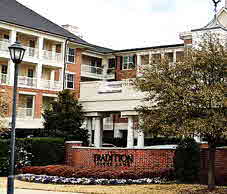 After a twelve-day jail stint Chemirmir began visiting another Dallas senior community, “The Tradition.” He was often seen there during the summer and fall of 2016, and when challenged said he was checking for pipe leaks. He was finally told to stay away. Chemirmir was eventually indicted for murdering seven of the home’s residents between July 2016 and October 2016: Joyce Abramowitz, 82; Juanita Purdy, 82; Leah Corken, 83; Margaret White, 86; Norma French, 85; Glenna Day, 87; and Doris Gleason, 92. (He is also thought to have killed a male resident, Solomon Spring, 89, but no charges have been filed.) After a twelve-day jail stint Chemirmir began visiting another Dallas senior community, “The Tradition.” He was often seen there during the summer and fall of 2016, and when challenged said he was checking for pipe leaks. He was finally told to stay away. Chemirmir was eventually indicted for murdering seven of the home’s residents between July 2016 and October 2016: Joyce Abramowitz, 82; Juanita Purdy, 82; Leah Corken, 83; Margaret White, 86; Norma French, 85; Glenna Day, 87; and Doris Gleason, 92. (He is also thought to have killed a male resident, Solomon Spring, 89, but no charges have been filed.)
Click here for the complete collection of crime & punishment essays
In November 2016 Tradition’s employees called police about “a suspicious person” who was frequenting the premises under guise of being a maintenance worker. Officers took a report and suggested tightening things up.
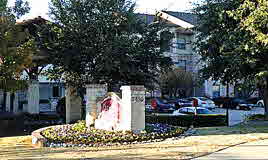 Nearly a year later, Chemirmir apparently turned his murderous attention to the suburbs. He’s been charged in the September 16, 2017 slaying of Marilyn Bixler, 90, a resident of “Parkview,” a retirement facility in Frisco. Five weeks later, a 93-year old Parkview resident survived an attempt to smother her with a pillow. Her assailant allegedly left with her jewelry. Nearly a year later, Chemirmir apparently turned his murderous attention to the suburbs. He’s been charged in the September 16, 2017 slaying of Marilyn Bixler, 90, a resident of “Parkview,” a retirement facility in Frisco. Five weeks later, a 93-year old Parkview resident survived an attempt to smother her with a pillow. Her assailant allegedly left with her jewelry.
Chemirmir remained lethally active. Three days before Christmas 2017 he committed an alleged eighth slaying at The Tradition. His victim was Doris Wasserman, 90. During this period Chemirmir is also alleged to have slain three residents of private homes in Plano, Dallas and Richardson: Carolyn MacPhee, 81, Rosemary Curtis, 75, and Mary Brooks, 88.
 His undoing ultimately came at “Preston Place”, a Plano retirement community. During the early morning hours of March 19, 2018, Chemirmir tried to suffocate resident Mary Bartel, 91, with a pillow. But after he left she regained consciousness and police were called. By then Chemirmir had allegedly killed at least four Preston Place residents: Minnie Campbell, 84, Martha Williams, 80, Miriam Nelson, 81, and, only one day earlier, Ann Conklin, 82. (We say “at least” because there were several suspicious deaths as well.) Of course, the cops didn’t know that. But mention of a vehicle registered to Chemirmir had appeared in past reports of suspicious activity at retirement homes. On the following day, officers staked out his Dallas-area apartment and saw him toss a jewelry box into the trash. Inside the box they found the name “Liu Thi Harris.” Dallas police rushed to the 81-year old woman’s home. They were too late. She had already been suffocated with a pillow. His undoing ultimately came at “Preston Place”, a Plano retirement community. During the early morning hours of March 19, 2018, Chemirmir tried to suffocate resident Mary Bartel, 91, with a pillow. But after he left she regained consciousness and police were called. By then Chemirmir had allegedly killed at least four Preston Place residents: Minnie Campbell, 84, Martha Williams, 80, Miriam Nelson, 81, and, only one day earlier, Ann Conklin, 82. (We say “at least” because there were several suspicious deaths as well.) Of course, the cops didn’t know that. But mention of a vehicle registered to Chemirmir had appeared in past reports of suspicious activity at retirement homes. On the following day, officers staked out his Dallas-area apartment and saw him toss a jewelry box into the trash. Inside the box they found the name “Liu Thi Harris.” Dallas police rushed to the 81-year old woman’s home. They were too late. She had already been suffocated with a pillow.
Chemirmir’s trial for murdering Ms. Harris began on November 15, 2021. Prosecutors played a video clip that depicted the accused and Ms. Harris inside a Walmart at the same time. The implication that Chemirmir followed her home was seconded by a January 2018 video clip from the same Walmart that paired him and a prior victim, Mary Brooks. Although Mary Bartel (she survived the suffocation attempt) had passed away, her deposition about the assault was admitted into evidence. Chemirmir’s alleged motive – to steal jewelry for resale – was also well supported. Ms. Harris’ jewelry box was identified by her son, and her jewelry and keys to her front door were found in Chemirmir’s car. Ms. Brooks’ daughter also testified that her mother’s safe and jewelry turned up missing. There was evidence that Chemirmir had offered jewelry from Ms. Bartel and Ms. Brooks for sale online, and a jewelry broker confirmed he made some purchases.
Still, the case wasn’t perfect. No deaths other than those of Ms. Harris and Ms. Brooks could be brought up. Ms. Bartel had never identified Chemirmir from a photograph, and physical evidence was lacking. As one might expect, Chemirmir didn’t take the stand. Criticizing the evidence as “all circumstantial” and the case as “quantity over quality,” the defense called no witnesses. While undoubtedly chancy, its gambit proved sufficient to convince one juror to hold out for acquittal. A mistrial was declared on November 19.
Chemirmir’s retrial kicked off on March 25. It was a literal replay. Again, the defense didn’t put on a case. Instead, his lawyers argued that prosecutors did not prove that Chemirmir entered Ms. Harris’ residence “beyond a reasonable doubt.” Once again, the case was supposedly “all bark, no bite.” Not this time. Things wrapped up on March 28. And it took the jury less than forty-five minutes to convict the “circumstantially” accused killer of murdering Ms. Harris. Chemirmir got life without parole.
According to the Daily Mail, as many as one-thousand elderly persons suffered “unexplained deaths” in Dallas-area nursing homes while Chemirmir was active. And some additional cases seem to be in the works. Still, none of the remaining seventeen indicted murders is known to offer a connection as compelling as the trail which led directly from Ms. Bartel’s assault to Ms. Harris’ jewelry box. Connecting Chemirmir to his victim would be essential. Ditto, a cause of death that doesn’t contradict suffocation. And recovering missing jewelry would be a big plus. Given Dallas County’s past tangles with wrongful convictions (its D.A. installed a pioneering “conviction integrity unit” in 2007) there’s little doubt that they’re likely to take care.
On October 19, 2018, Memphis police arrested a Chicago man, Jimmy Jackson, 72, on a Cook County warrant that accused him of murdering a 62-year old Chicago woman who had gone missing five months earlier. Family members who reported Daisy Hayes missing told police that they were certain that her boyfriend, Mr. Jackson, had killed her. And the cops clearly agreed.
 Mr. Jackson stayed locked up until his trial last month. And the circumstances pointing to his guilt sure seemed compelling. A surveillance video showed Jackson wheeling away a heavy, bulging suitcase from the building where each had an apartment. And yes, it was big enough to fit, as Ms. Hayes was barely over five tall and weighed a mere 85 pounds. Other videos depicted Mr. Jackson, with some difficulty, throwing the suitcase in a dumpster, then covering it with trash from other dumpsters. He then left with his own (non-bulging) suitcase. Apparently, heading for Memphis. Mr. Jackson stayed locked up until his trial last month. And the circumstances pointing to his guilt sure seemed compelling. A surveillance video showed Jackson wheeling away a heavy, bulging suitcase from the building where each had an apartment. And yes, it was big enough to fit, as Ms. Hayes was barely over five tall and weighed a mere 85 pounds. Other videos depicted Mr. Jackson, with some difficulty, throwing the suitcase in a dumpster, then covering it with trash from other dumpsters. He then left with his own (non-bulging) suitcase. Apparently, heading for Memphis.
Alas, Ms. Hayes’ body was never found. And there was no DNA or physical evidence. Ms. Hayes hadn’t been answering phone calls, and it was two weeks before family members came looking. They must have found the place quite tidy, as video depicted Mr. Jackson going in and out with cleaning supplies.
Be sure to check out our homepage and sign up for our newsletter
This wasn’t Mr. Jackson’s first serious go-round with the cops. He had been arrested for a double homicide years earlier, but prosecutors dropped the case after witnesses didn’t show. So his lawyer had to assess things very carefully. And he reached a unique conclusion. There was no body. All that potentially nasty evidence was circumstantial. Let a judge decide!
On Friday, April 22, 2022 Cook County Judge Diana Kenworthy rendered the verdict. Cleaning an apartment isn’t a crime. Ms. Hayes was elderly and had been drinking. And there was no physical or biological evidence that a crime had even occurred. She found Mr. Jackson not guilty.
“This one conviction represents justice for all of the families.” That’s how the daughter of one of Chemirmir’s victims welcomed the jury’s verdict. In contrast, the judge’s acquittal of Jimmy Jackson left Daisy Hayes’ daughter in tears. “Four years we’ve been fighting this, and all we got was a not guilty verdict.” We don’t deny that the circumstances presented at Chemirmir’s trial were compelling. But we’re equally convinced that a bulging suitcase, plus those trash bins, plus all that scrubbing, plus a sudden relocation to another state would have caused a whole lot of mutually-reinforcing chatter in a jury room, had Jackson opted for one. But his lawyer probably felt that a judge, deciding alone, would set tempting but inconclusive circumstances aside in favor of a more legally-focused argument, say, the lack of a clear motive and the absence of a corpse.
And the gamble paid off, if not for justice, at least for the accused.
UPDATES (scroll)
5/30/24 On April 20, 2020, the Supreme Court ruled that non-unanimous jury verdicts in criminal trials were unconstitutional (Ramos v. Louisiana, no. 18-5924). These had been allowed in only two States: Louisiana and Oregon. Although D.A.’s warned about a rash of hung juries, Louisiana’s voters enacted a law requiring unanimity in late 2018. Studies comparing the ratio of hung juries before and after the law’s implementation found no substantial difference. Jury deliberations, though, are lengthier, possibly because it takes time to convince holdouts to change their minds.
9/20/23 Billy Chemirmir, who was serving two life sentences in a Texas prison for murdering two elderly women he met while pretending to do maintenance work at senior living homes, was murdered by his cellmate, also a convicted murderer. Chemirmir, who may have have killed as many as two-dozen women during his years-long spree, was caught after a 91-year old woman survived an attack in 2018 and informed police.
10/10/22 Jurors took less than thirty minutes to convict Billy Chemirmir in the smothering death of Mary Brooks, one the nearly two-dozen elderly women he allegedly murdered in a years-long spree. It was his second Dallas-area conviction, and second sentence of life without parole, so local prosecutors are reportedly letting eleven other cases go. But he also faces nine murder cases in Collin County.
|
Did you enjoy this post? Be sure to explore the homepage and topical index!
Home Top Permalink Print/Save Feedback
RELATED POSTS
A Victim of Circumstance Fewer Can be Better
Posted 4/4/22
JUDICIAL DETACHMENT: MYTH OR REALITY?
A Supreme Court candidate gets slammed for liberal bias

For Police Issues by Julius (Jay) Wachtel. In his prior life as a Fed your writer frequently authored detailed affidavits while seeking arrest and search warrants for gun crimes. But the sworn declaration he just downloaded from the D.C. Federal court’s PACER website is by far the most nauseating such document that he’s ever read (case no. 1:13-cr-00244-KBJ).
In 2013 the Washington D.C. FBI Child Exploitation Task Force was tipped that someone had been uploading videos to the Internet showing naked “prepubescent boys” engaging in oral and anal sex. An undercover D.C. police detective subsequently exchanged emails with the suspect, Wesley Hawkins, 18. Hawkins wrote that “he likes children ages 11 to 17, and that he has videos to share.” And he did, sending on two “of a prepubescent male masturbating.”
Other tips led to the discovery of two-dozen-plus videos and still images uploaded by Hawkins that depicted male and female children and prepubescent boys flaunting their intimate parts and engaging in oral and anal sex. In June 2013 officers served a search warrant at his residence. They turned up a laptop replete with child pornography. It reportedly included:
Click here for the complete collection of crime & punishment essays
“24:06 minute video depicting an approximately 12 year-old male masturbating before a web camera; 1:57 minute video depicting an approximately 8 year-old male masturbating before a web camera; 11:47 minute video depicting an approximately 11 year-old male masturbating and being anally penetrated by an adult male; 15:19 minute video depicting two approximately 11 year-old males masturbating and performing sexual acts on each other; 7:51 minute video depicting an approximately 12 year-old male masturbating....”
Note that at least one video featured an “adult male” participant (no, it wasn’t Hawkins). Hawkins initially denied everything. But he soon conceded that his laptop held some deeply incriminating goods.
He wasn’t accused of actually taking the videos. Still, by posting and sharing them he had participated in a process that can profoundly damage children. Hawkins soon pled guilty to one count of possessing child pornography [18 USC 2252A(a)(5)(B)]. Since some of the affected minors were less than twelve years of age, he could have hypothetically drawn as many as twenty years. Sentencing-wise, several potential enhancements did apply:
...the material involved prepubescent minors or minors under the age of 12 (+2); the offense involved distribution (+2); the material portrayed sadistic or masochistic conduct (+4); the offense involved the use of a computer (+2); the offense involved 600 or more images (+5)...
Given Hawkins’ lack of a prior criminal record, Sentencing Commission guidelines called for a range of 97 to 121 months imprisonment. His youth and cooperation, though, led prosecutors to recommend a more lenient disposition: twenty-four months custody followed by 96 months of supervised release.
So what did Hawkins actually get? Well, some of our readers likely know. But don’t fret: we’ll return to Mr. Hawkins in a moment.
On January 27, 2022 U.S. Supreme Court Justice Stephen Breyer revealed that after twenty-seven years on the nation’s high court, he was ready to retire. Less than a month later President Joe Biden announced that in line with his pledge to appoint a Black woman as the next Justice, he had selected D.C. Circuit Court of Appeals Justice Ketanji Brown Jackson to fill the vacancy. His official statement led off with the two core principles that everyone hopes underlie judicial decisionmaking:
Because of her diverse and broad public service, Judge Jackson has a unique appreciation of how critical it is for the justice system to be fair and impartial [emphasis ours]. With multiple law enforcement officials in her family, she also has a personal understanding of the stakes of the legal system. After serving in the U.S. Army and being deployed to Iraq and Egypt, Jackson’s brother served as a police officer in Baltimore and two of her uncles were police officers in Miami.
As one would expect, Justice Jackson’s qualifications are indeed awesome. Even so, President Biden knows that given the constituencies that some Senators must please, her confirmation could present a struggle even within the “Blues.” And with the Senate evenly split, literally every vote “counts.” That, in turn, may explain why the President’s comments emphasized that Justice Jackson has family ties to, well, the cops.
Nominated by President Bill Clinton, Justice Breyer was considered a “Blue” sort. Ditto his anointed successor. Her selection reflects the Red/Blue, right/left, conservative/liberal ideological divide that Professor Richard Hasen claims (“Polarization and the Judiciary”) has long guided the selection of State and Federal judges and justices, deeply affecting outcomes in fraught areas such as guns, abortion and affirmative action. As for the Supreme Court, professors Neal Devins and Lawrence Baum (“Split Definitive: How Party Polarization Turned the Supreme Court into a Partisan Court”) conclude that its decisions have closely tracked Party lines for over a decade:
Since 2010, when Elena Kagan replaced John Paul Stevens, all of the Republican-nominated Justices on the Supreme Court have been to the right of all of its Democratic-nominated Justices. This pattern is widely recognized, but it is not well recognized that it is unique in the Court’s history. Before 2010, the Court never had clear ideological blocs that coincided with party lines.
Professors Andrew Martin and Kevin Quinn devised a widely accepted approach that uses Supreme Court decisions to scale Justices’ ideological preference, from the most liberal (-5.0) to the most conservative (+5.0). An M-Q score gets assigned to each Justice at the end of every term. Check out our lead graphic. Excepting Justices Gorsuch, Kavanaugh And Barrett, who began in 2016, 2018 and 2020 respectively, the left-side score represents the year 2010. Here’s a companion visual that tracks M-Q’s thru 2020:

With a couple of exceptions (note Roberts’ moderation and Sotomayor’s plunge from moderately liberal to off-the-charts) M-Q scores remain remarkably consistent, term-in and term-out. But put decisions aside. In “Split Definitive” Professors Devins and Baum highlight the salience of ideology by analyzing Justices’ preferences when it comes to hiring clerks. This graphic depicts the proportion of clerks during the 2005-2016 terms who had served lower-court judges appointed by Republicans.
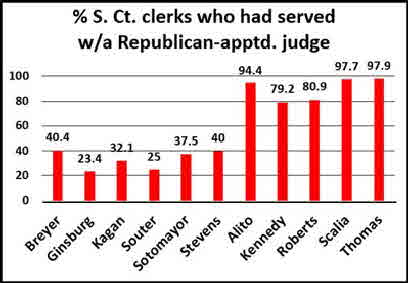
It’s clear that the conservative Justices (the five on the right) were determined to hire clerks with “Red” backgrounds, while their liberal colleagues preferred those of the “Blue” persuasion.
That Justices are ideologically split is old news. (For a list of relevant articles and news pieces click here.) Indeed, it’s assumed that each will come down on a certain side in every ideologically-charged decision. Here, for an example, is an extract from a recent story in the Los Angeles Times about a case before the Court. Apparently, the California business community (read: conservative-leaning) is challenging a State law, which has been backed by State court decisions, that lets workers sue employers even though they supposedly agreed when hired that all disputes would be arbitrated:
The court’s conservative justices said little during Wednesday’s argument in Viking River Cruises vs. Moriana, while the three liberals spoke in defense of the California law. “This is the state’s decision to enforce its own labor laws in a particular kind of way,” Justice Elena Kagan said.
California is reportedly the only State that does that. Its high court refused to hear an appeal, but the U.S. Supreme Court has taken on the case. Given its present conservative majority (and Justice Kavanaugh’s mention that “California is an outlier here”) a business-friendly ruling seems likely.
But what does judicial ideology have to do with our (hopefully, one-time) fan of child pornography? A lot. You see, Wesley Hawkins’ three-month sentence, whose length was one-eighth of what the prosecutor recommended, was handed down by D.C. Court of Appeals Justice – now, Supreme Court nominee – Ketanji Brown Jackson while she served as a D.C. District Court judge. Justice Jackson, who began her Government career as a Federal Public Defender, has been severely criticized by Republicans for demonstrating “empathy” (i.e., leniency) when sentencing Hawkins and other child pornographers.

We downloaded several documents from Mr. Hawkins’ criminal case. This graphic depicts two of the final entries on the index page: the judgment (click here for the document) and an accompanying “Statement of Reasons.” Ostensibly, the latter would have explained Judge Jackson’s pronounced “downward departure” from the two-year term recommended by prosecutors, which was itself substantially less than what Sentencing Commission guidelines prescribe. Alas, clicking on the link returned “not available.”
So we turned to FactCheck.org. Their extensive coverage of the case includes Justice Jackson’s explanation of her sentencing sentencing decision during questioning by her most ardent antagonist, Senator Josh Hawley (R-Mo). Here’s a brief extract:
I remember in that case that defense counsel was arguing for probation, in part because he argued that here we had a very young man just graduated from high school. He presented all of his diplomas and certificates and the things that he had done and argued consistent with what I was seeing in the record that this particular defendant had gotten into this in a way that was, I thought, inconsistent with some of the other cases that I had seen.
FactCheck looked into seven child-pornography sentences that supposedly reflect Justice Jackson’s excessively forgiving nature. Our graph orders them according to the recommended sentence under the guidelines (black bar), from the least severe (left) to the most (right). Mr. Hawkins’ case is the fourth.
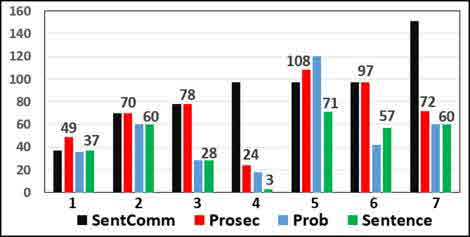
In each, the actual sentence given by then-judge Jackson was less than what prosecutors had sought, and in four cases (#3, #4, #5 and #6) substantially so.
Justice Jackson has said that her sentences were not overly lenient. “Nothing could be further from the truth,” she insists. Yet her obvious empathy for the accused has become a “flashpoint.” It’s not that she ignores victims. While sentencing Mr. Hawkins she agonized about “children who are being trapped and molested and raped for the viewing pleasure of people like yourself.” The case file included a statement from one of the youths depicted in the images which “describes how being a victim of child pornography has affected many areas of the victim’s life, including the victim’s inability to trust adults and struggle with anger issues.” Yet then-Judge Jackson held back. “You were only involved in this for a few months...Other than your engagement with the undercover officer, there isn’t an indication that you were in any online communities to advance your collecting behavior.”
Be sure to check out our homepage and sign up for our newsletter
Did Mr. Hawkins’ sentence convey a sufficiently stern warning? Perhaps not. According to a Washington Post investigation (it’s otherwise very favorable to the Justice) a probation document filed as Mr. Hawkins’ term of supervision neared its end reported that “despite being in treatment for more than five years [Mr. Hawkins] continues to seek out sexually arousing, non-pornographic material and images of males 13 to 16-years-old.” He had to serve his last six months of release in a halfway house.
Over the years we’ve repeatedly mentioned the “tendency to seek out information and interpret events in a way that affirms one’s predilections and beliefs.” That nasty interloper – its official title is “confirmation bias” – can affect most anyone, from out-and-out ideologues to supposedly objective, data-driven scientists. And, as our graphs seem to demonstrate, Supreme Court justices. But Justice Jackson denied that she purposely aligned with either the “Reds” or the “Blues”:
I decide cases from a neutral posture. I evaluate the facts, and I interpret and apply the law to the facts of the case before me, without fear or favor, consistent with my judicial oath.
Might she prove an exception to the rule?
Ask us in a couple years, once her M-Q scores are in.
UPDATES (scroll)
6/30/25 The Supremes are yet to decide whether being born in the U.S. carries automatic citizenship. According to President Trump’s Executive Order #14160, it does not. But their just-issued decision in Trump v. CASA et al. (24A884) bars Federal District courts from issuing injunctions whose effects extend beyond their geographical boundaries. That follows on cases in Maryland, Washington State and Massachusetts where Federal judges ruled for birthright and against Trump. And yes, the decision was split 6-3, with the three liberal Justices (Sotomayor, Kagan and Jackson) dissenting.
4/8/25 In an ideologically-split 5-4 decision, the Supreme Court lifted the D.C. Court’s restraining order that barred the deportation of alleged gang members under the Alien Enemies Act. In Trump v. J.G.G., et al., the majority ruled that persons detained under the Act “must receive notice...that they are subject to removal under the Act...within a reasonable time and in such a manner as will allow them to actually seek habeas relief....” That application for “relief” must be in their local venue. But the ruling explicitly did not attend to the merits of the case, leaving it for the District judge to decide.
4/7/25 The late Supreme Court Justice Sandra Day O’Connor, who died on December 1, 2023, feared that political partisanship can distort judicial decisionmaking: “You can get decent judges by election. But what you get these days is large campaign contributions when you have elections...How can the judge be expected to be absolutely fair and impartial?” She favored having judicial commissions select judges for provisional terms. They would be objectively evaluated, then stand for election (yes/no) to a full term.
10/16/24 Justice Sonia Sotomayor earned $3.7 million in royalties from her children’s books between 2009, when she was appointed to the Supreme Court, and last year. Sales were supposedly stimulated by personal appearances and prodding from her staff. And now fellow Justice Neil Gorsuch is under watch over his “cozy relationship” with oil mogul Philip F. Anschultz, who would be well served if the Court decides in his favor on a pending environmental case. Alas, the Court lacks external oversight. No one is watching the watchers.
9/25/24 Marcellus Williams, 55, who was convicted in June 2001 for the 1998 murder of Felicia Gayle, was
executed on Sept. 24 at 6:00 pm Central Time. It was Missouri’s third execution of the year and its 100th.
since 1989, when the State’s use of the death penalty was restored. A last-ditch effort for a stay had been
approved only hours earlier by the Supreme Court’s three most liberal justices, Sotomayor, Kagan and Jackson.
But their colleagues disagreed,
and the execution proceeded as scheduled.
8/2/24 “In recent years, extreme opinions the Supreme Court has handed down have undermined long-established civil rights principles and protections.” With those words a very “Blue” President Joe Biden proposed a Constitutional amendment that would limit Justices to eighteen-year terms. Questioning their “fairness and independence”, he also recommended that the Justices be subject to an enforceable ethics code. As one would expect, the “Reds” called his proposal “dead on arrival.”
7/1/24 In a new decision, the Supreme Court ruled that 18 USC 1512(c)(2), which prohibits obstructing official proceedings, is constrained by the language of section (c)(1), which applies only to someone who “alters, destroys, mutilates, or conceals a record, document, or other object, or attempts to do so.” Merely crashing the Capitol isn’t enough. While no Jan. 6 rioters were reportedly charged with only (c)(2), it’s a felony, and more than two dozen are serving prison time for its violation. It also accounts for two of the four Jan. 6-related charges against ex-president Trump. Split 6-3, the decision aligned with the Court’s ideological divide, with conservatives in the majority. Fischer v. U.S.
6/14/24 Two years after the 2017 Las Vegas massacre, in which bump stock-equipped rifles were used to murder sixty, ATF ruled that the devices, which it previously permitted, were illegal machinegun conversion parts. But Federal law defines machineguns as firing repeatedly with a single trigger pull. Bump stocks use recoil to repeatedly pull the trigger while it’s depressed. That difference led the 5th. Circuit to strike down ATF’s ruling as inconsistent with the law. And in a 6-3 decision that aligns with its ideological split, the Supreme Court just agreed. To outlaw bump stocks, the law itself must change. States, though, appear free to outlaw bump stocks if they wish. Garland v. Cargill
5/23/24 Neighbor accounts and photos reveal that last summer an “Appeal to Heaven” flag graced the Long Beach Island, NY summer home of Supreme Court Justice Samuel A. Alito and his wife. Carried by the January 6 rioters who stormed the Capitol, it symbolizes “a theological vision of what the United States should be and how it should be governed.” It’s also been prominently displayed by a “Stop the Steal” leader and by Rep. Mike Johnson, the (Red) Speaker of the House of Representatives.
5/17/24 Supreme Court Justice Samuel A. Alito Jr. insists that he had nothing to do with the upside-down flag that was displayed in front of his house for several days preceding President Biden’s inauguration. Instead, the so-called “Stop the Steal” flag was placed there by his wife, who objected to a neighbor’s sign that referred to Donald Trump with an expletive. But “judicial experts” interviewed by the New York Times insist that the flag violated ethics rules. Justice Alito is regarded as the Court’s second-most conservative member (Justice Clarence Thomas comes in first.)
Keep going...
|
Did you enjoy this post? Be sure to explore the homepage and topical index!
Home Top Permalink Print/Save Feedback
RELATED ARTICLES AND REPORTS
Washington Post inquiry into “judge shopping”
RELATED POSTS
Bail and Sentencing Reform special topic
Switching Sides Ideology (Still) Trumps Reason Guilty Until Proven Innocent
Posted 1/29/22
WHAT’S UP? VIOLENCE.
WHERE? WHERE ELSE?
As usual, poor neighborhoods shoulder most of the burden
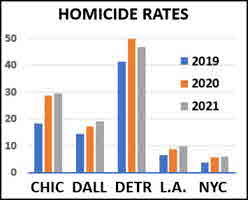
For Police Issues by Julius (Jay) Wachtel. “I just want justice for my child, that’s all.” That soul-stirring sentiment, expressed by a disconsolate Chicago-area father after the shooting death of his fourteen-year old son on November 12th., likely echoed the reaction of the parents of another 14-year old boy, slain nearby just a few hours later. Indeed, the murderous reputation of Englewood, the neighborhood where the second killing took place, recently led us to use it in an essay entitled “The Usual Victims”.
Yet as one scours for insights into the murderous violence that’s beset our troubled nation since the murder of George Floyd and the beginning of the pandemic, neighborhoods are ignored. Academically and in the media, the focus is on cities. Of course, place matters. (We even have a post of that name! But as it emphasizes, to really understand why the violence, and how best to respond, one must ultimately go beyond political aggregates such as cities and drill down to neighborhoods. That’s the principle that underpins our “Neighborhoods” special topic. But before we apply that approach, let’s turn to five major cities – Chicago, Dallas, Detroit, Los Angeles and New York City – to assess whether a “crime wave” really exists.
Click here for the complete collection of crime & punishment essays
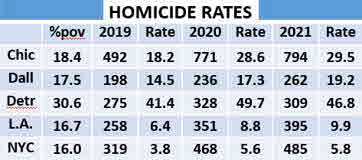 These are the numbers that go along with our opening homicide graph. (Sources listed below. Rates per 100,000 pop. were computed using city population figures in FBI and Census portals.) These are the numbers that go along with our opening homicide graph. (Sources listed below. Rates per 100,000 pop. were computed using city population figures in FBI and Census portals.)
Clearly, each city endured substantial increases in murder. Detroit’s numbers are truly deplorable, Chicago’s a bit less so. Still, note that 57 percent increase in murders for 2020. Los Angeles and New York City, which started off and ended in a far better place, also experienced substantial increases that year (36 percent and 46.7 percent respectively.) And except for Detroit, which reported fewer homicides in 2021, murder rates kept getting worse.

While America is decidedly on the wrong track homicide-wise, aggravated assault presents a more complex picture. Each city experienced a substantial increase in 2020; Detroit’s already sky-high figures surged 21.7 percent. And while the Motor City and Dallas endured another jump in 2021, Chicago, Los Angeles and New York City experienced declines. In the latter two, the numbers actually fell below 2019 levels.

What about robbery? Chicago didn’t experience a significant change in rates. New York City reported a handful more robberies in 2021 than in 2019. Dallas and Detroit, on the other hand, demonstrated significant improvement; Los Angeles, a tad less so.
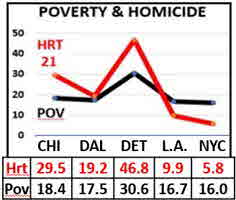 So is violent crime up or down? Homicide rates went up between 2019 and 2021 in each city in our cohort, and in Chicago and Detroit substantially so. Aggravated assault rates increased in Chicago, Dallas and Detroit but receded somewhat in Los Angeles and New York City. Robbery numbers, though, mostly decreased. Bottom line: when it comes to crimes whose objective is to injure or kill – i.e., murder and aggravated assault – things are bleak, and particularly so in the poorer cities. Over the years, the numbers we’ve crunched demonstrate a strong link between poverty and violence, and especially homicide (see, for example, our recent review of ten major cities in “Woke Up, America!”). That’s borne out here. (Note that we cite Chicago’s Census poverty numbers but they’re generally considered a couple points too low). So is violent crime up or down? Homicide rates went up between 2019 and 2021 in each city in our cohort, and in Chicago and Detroit substantially so. Aggravated assault rates increased in Chicago, Dallas and Detroit but receded somewhat in Los Angeles and New York City. Robbery numbers, though, mostly decreased. Bottom line: when it comes to crimes whose objective is to injure or kill – i.e., murder and aggravated assault – things are bleak, and particularly so in the poorer cities. Over the years, the numbers we’ve crunched demonstrate a strong link between poverty and violence, and especially homicide (see, for example, our recent review of ten major cities in “Woke Up, America!”). That’s borne out here. (Note that we cite Chicago’s Census poverty numbers but they’re generally considered a couple points too low).
City boundaries are artificial constructs. What about neighborhoods, the places where people actually live? Patterning our efforts on “The Usual Victims”, “Woke up, America!” and “Fix Those Neighborhoods!” we collected 2019-2021 data on homicide, aggravated assault and robbery for two patrol areas in Los Angeles and two in New York City. Each pair was purposely comprised of one prosperous area and one that’s economically deprived. L.A.’s pair includes LAPD’s well-to-do West Los Angeles sector (pop. 228,000, pov. 11.3%) and chronically poor 77th. Street (pop. 175,000, pov. 30.7%). For New York City the pair includes the 19th. precinct, which covers Manhattan’s wealthy Upper East Side (pop. 220,000, pov. 7.2%) and the 73rd., which serves Brooklyn’s impoverished Brownsville and Ocean Hill areas (pop. 86,000, pov. 29.4%).
How did these places fare violent-crime-wise? Let’s grab a look.
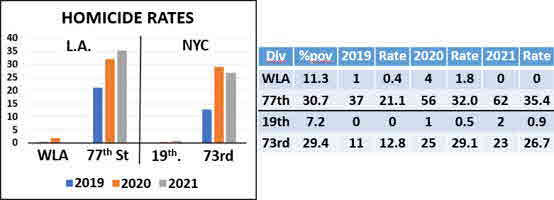
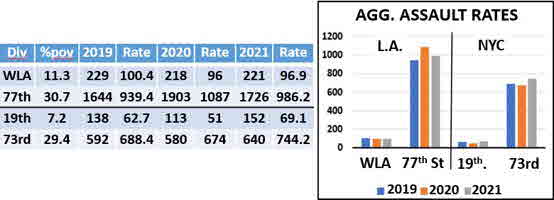
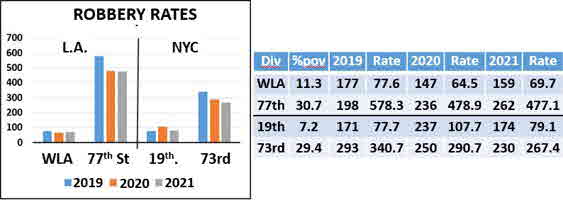
Our neighborhoods forays consistently reveal a strong relationship between poverty and violence (see, for example, “Location, Location, Location” for Los Angeles, and “Repeat After Us,” “Be Careful What You Brag About” and “Place Matters” for New York City). As expected, L.A.’s 77th. St. and New York City’s 73rd. endured far higher rates of homicide, aggravated assault and robbery than their prosperous counterparts. Their homicide surge in 2020 – 51.4% in L.A.’s 77th. St., 127.3% in NYC’s 73rd. – seems remarkable. Aggravated assault followed a different pattern. Just like for the city cohort, rates increased at first in Los Angeles and retreated in New York City. On the other hand, robbery, a hybrid crime, was clearly on a downtrend. Most robberies don’t cause physical injury – that’s not their objective – and if it was up to us, we’d assign them to the “property” camp.
According to the FBI, violent and property crimes are continuing to move in opposite directions. In late 2018 violent crime reversed a two-year downtrend and shot back up while property crimes, including burglary, continued a decade-plus plunge. FBI numbers don’t cover all of 2021, so we used city data (sources below) to prepare two burglary graphs, one for the five-city cohort and another for the rich area/poor area comparo.


Burglary charted a seemingly benign course, with rates in each city except New York winding up lower in 2021 than in 2019. But in many areas the threshold for “serious” property crime has increased. For example, in 2014 California Proposition 47 constrained the circumstances under which burglary can be charged. That makes us reluctant to interpret burglary’s recent changes in rate, either between cities or within. So let’s go back to violence. We’ll start with a bit of self-plagiarism from “Woke up, America!”:
Best we can tell, the middle-class neighborhood where my wife and I reside has been free of violent crime, or any property crime of consequence, for, um, thirty years. Many of our readers can probably boast likewise. To be sure, drive a couple miles one way or the other and things can get gloomy. And that’s within the same city.
That “gloominess” seems to be worsening. A profusion of soul-shattering acts of violence have welcomed the new year. On January 10th three robbers got into a gunfight with LAPD officer Fernando Arroyos, 27, who was off-duty and house-hunting with his girlfriend in challenged South Los Angeles. Officer Arroyos, a Cal Berkeley grad who had dreamed to be “first in his family to go to college and to be an LAPD officer,” was mortally wounded. On the opposite shore, an appalling five on-duty NYPD officers were shot during the first three weeks of this year. In the fourth, most recent episode, Officer Jason Rivera, a 22-year old rookie, was killed and his partner, Wilbert Mora, 27, a four-year veteran was critically wounded (sadly, he later passed). Their assailant was a middle-aged man whose mother had called 9-1-1 about his aggressive behavior. She didn’t mention – nor apparently, was she asked – if he had a gun. It turned out to be a Glock .45 with a high-capacity magazine.
Seventy-three American law enforcement officers were feloniously slain in 2021, sixty-one by gunfire. That deplorable toll surpassed the former decade-high sixty-six in 2016. It’s also a full one-third worse than in 2019, when forty-eight officers were victims of homicide, and 2020, when forty-six fell. And it’s not just cops. An unending stream of news accounts depicts a growing hazard for ordinary folks as well. On January 13th. a homeless man with an extensive criminal record fatally stabbed a beloved UCLA graduate student, Brianna Kupfer, 24, while she was tending to a Los Angeles-area furniture store. One day later a balloon release marked a pledge by challenged Chicago neighborhoods to “come together and  work together” to end the violence that cost the lives of two 14-year olds in separate shootings two days earlier. One week later, in another troubled Chicago area, eight-year old Melissa Ortega was fatally wounded and several passers-by experienced a near-miss when a 16-year old gang member unleashed a barrage at a rival gangster. Out on probation for two carjackings, the shooter was arrested and (this time) is being held without bond. work together” to end the violence that cost the lives of two 14-year olds in separate shootings two days earlier. One week later, in another troubled Chicago area, eight-year old Melissa Ortega was fatally wounded and several passers-by experienced a near-miss when a 16-year old gang member unleashed a barrage at a rival gangster. Out on probation for two carjackings, the shooter was arrested and (this time) is being held without bond.
Why the carnage is a matter of considerable debate. According to the New York Times’ David Brooks, polarization and anger fueled by a host of spiritual, cultural and moral poisons have led America’s social compact to come undone:
But something darker and deeper seems to be happening as well — a long-term loss of solidarity, a long-term rise in estrangement and hostility. This is what it feels like to live in a society that is dissolving from the bottom up as much as from the top down.
Los Angeles offers bountiful examples of that “dissolving.” For an example of our society’s coming apart at its more privileged levels consider the June 1, 2021 killing of an L.A. County firefighter, and the wounding of his Captain, by an angry colleague who barged in to the fire station. And for an example of our fracture at the opposite end, there’s the January 22, 2022 gang-related massacre in struggling Inglewood, which took the lives of four persons in their early twenties, including the birthday party’s “beautiful young” honoree.
Police aren’t well positioned to keep unstable firefighters from lethally acting out. On the other hand, getting tough on armed thugs is supposedly right up their alley. Mr. Brooks’ employer, a news source whose editorial position hasn’t often aligned with the cops, recently lent its forum to a Princeton sociologist who thinks that maybe the police do play at least one vital role:
We don’t have another set of institutions that can deal with the problem of gun violence, or at least we don’t have many institutions that can deal with the problem of gun violence. What I would argue is that they should move to the background, and police should be called when a gun is involved.
Dr. Patrick Sharkey isn’t suggesting that cops get deeply involved in “ordinary” stuff. But when it comes to gun violence, who else is there?
Be sure to check out our homepage and sign up for our newsletter
What do we think? Grab a peek at “Full Stop Ahead.” Blowback from George Floyd’s murder and the constraints of the pandemic set off a flurry of reforms and adjustments that relaxed criminal sanctions, slashed prison and jail terms and reduced the oversight of offenders under supervision and those awaiting trial. Law enforcement staffing plunged and is yet to recover. Policing was severely dialed back, and proactive anti-crime strategies wound up on the back-back burner. But as violence continues, adjustments seem inevitable. Despite concerns by progressives who welcomed him to office, ex-police captain Eric Adams, New York City’s second-ever Black mayor, is planning to reinstate NYPD’s plainclothes teams (albeit, in a seemingly milder form.) And for a real head-snapper consider the situation that Manhattan’s new D.A., Alvin Bragg found himself in. Elected on a progressive, reformist plank, he even promised to seek leniency for those caught with a gun. But a sharp rise in violence has led to a “shift in tone.” Mr. Bragg recently appointed a special lawyer to handle gun-related work, and “more than fifty” gun possession cases are reportedly in the pipeline.
 One of our very first posts, “Of Hot-Spots and Band-Aids,” expressed concern that intensive policing may be thought of as a permanent solution. As our “Neighborhoods” posts repeatedly implore, focused law enforcement practices can’t (and shouldn’t) substitute for investments in job training, education, health care and childcare. But when violence and gunplay rule the streets, “geographically focused policing initiatives” (that’s that NIJ calls them) could help prevent the murder of eight-year olds and get society back on track. So maybe it’s time to bring cops and out-of-mode strategies such as hot-spots policing back into the picture. All that’s needed is to get America’s badly polarized political class on board. One of our very first posts, “Of Hot-Spots and Band-Aids,” expressed concern that intensive policing may be thought of as a permanent solution. As our “Neighborhoods” posts repeatedly implore, focused law enforcement practices can’t (and shouldn’t) substitute for investments in job training, education, health care and childcare. But when violence and gunplay rule the streets, “geographically focused policing initiatives” (that’s that NIJ calls them) could help prevent the murder of eight-year olds and get society back on track. So maybe it’s time to bring cops and out-of-mode strategies such as hot-spots policing back into the picture. All that’s needed is to get America’s badly polarized political class on board.
Alas, that chore is definitively beyond our pay grade.
UPDATES (scroll)
6/30/25 Chicago’s Crime Gun Intelligence Center (CGIC), a partnership between local police departments and ATF, brings officers together to track the paths that guns took on their way to misuse and to link them, using advanced ballistics techniques, to shell casings found at current and past crime scenes. Non-fatal shootings, of which there were 1,800 last year, get much of the team’s attention, and solution rates in such cases have significantly improved. (See 4/19/24 update)
Three males ages 16, 18 and
19 lay dead, and fifteen other persons, ages 16 to 36 were wounded by gunfire that broke out between rival groups during an
“unauthorized” late evening car show in a Las Cruces, New Mexico park. Police later arrested a 20-year old male and two 17-year old teens.
Gov. Michelle Grisham, who recently approved a host of anti-crime measures, attributed her State’s chronically high violence to
“the amount of guns that find their ways into public parks and schools and churches and grocery stores and parties and
cars.” Las Cruces’ poverty rate, 22%, is twice
that of the U.S. (11.1%) and about a quarter higher than New Mexico’s 17.8%.
7/26/24 Twenty Los Angeles-area intersections that have become “hot spots” for street takeovers are slated for speed bumps. But none of these locations were the scene of the latest spate. In LAPD’s chronically beset South Bureau, a 15-year old spectator was fatally shot by a robbery crew, and his teen companion was wounded. Gunfire also broke out at a takeover in nearby Compton, leaving two wounded. Elsewhere, celebrants looted a restaurant, busted a fire hydrant, and set a vehicle ablaze. According to LAPD data, there were 319 takeovers in 2019, 912 in 2020, and 482 in 2023.
7/5/24 Gunfire broke out in Corryville, a Cincinnati neighborhood, during the early morning hours of July 1st. Three persons were shot dead and a fourth, who was wheelchair-bound from a prior shooting, was wounded. An unidentified armed man ran into a nearby home and was arrested. Those killed include Shawn McDaniel Sr., 45 and his son, Shawn McDaniel Jr., 22. A convicted drug dealer, McDaniel Sr. authored two graphic novels, Cincinnati Jack Boy$ and 80’s Baby, about life, drugs and death on Cincinnati streets.
7/3/24 Situated on an ocean bluff, it doesn’t get any “tonier” than Newport Beach, Calif.’s “Fashion Island”. Nor, as shoppers discovered during a “tranquil afternoon”, more lethal. Robbers accosted an elderly couple strolling outside the exclusive stores. Shots were fired, and the assailants dragged the woman to the parking lot and fatally struck her with their car. Four suspects were arrested after a protracted air-and-ground pursuit. “This doesn’t happen in Newport Beach,” said the Mayor. “Fashion Island is an incredibly safe place. This is a tragedy, and I’m furious.”
6/26/24 Five North Las Vegas residents, including four women ages 20-50 and a man in his twenties, were shot to death in nearby apartments. A teen-age girl was critically wounded. After an overnight search police were informed that the 57-year old suspect, Eric Adams, was at a local business. When they arrived he ran into a nearby backyard. He refused to drop his gun and committed suicide.
6/25/24 Forty-five Chicagoans were shot one weekend ago; seven fatally. This weekend the toll was a lesser twenty-nine. But nine died, including two 16-year olds. One was fatally struck, and his two teen companions were wounded, by gunfire from a passing SUV. That happened Friday night. The other fatally wounded youth was shot multiple times during a dispute in a park. That was on Saturday. And on Sunday, a gunshot detection system alerted police to a 19-year old who had been repeatedly (and, fatally) shot. Details about other episodes are in the Chicago Tribune.
6/24/24 Mass shootings continue besetting the land. Shoppers dove for cover as a man armed with a shotgun opened fire at a Fordyce, Arkansas grocery store. Travis Eugene Posey, 44 shot and killed four and wounded nine, including two police officers. Posey was also wounded and taken into custody. Fordyce, a town of about 3,400, is about 10 miles from New Edinburg, the hamlet where the shooter lived. And in downtown Columbus, Ohio, an early morning shooting wounded ten persons, ages 16-27, one critically. The gunman, who was reportedly dressed in black, fled in a waiting car. He remains at large.
6/20/24 Seven-year old Jai’Mani Amir Rivera stepped out of his Chicago Near West Side apartment to visit a friend. Suddenly a “random” bullet fired from a considerable distance struck him in the chest, inflicting a fatal wound. Not long ago a five-year old was shot and killed nearby. According to residents of the Oakley Square complex where Jai’Mani lived, gunfire is common. It’s in ZIP 60612, poverty 29.1%.
6/3/24 In Akron, a noisy, fireworks-laden gathering brought two-hundred celebrants into a residential street late Sunday evening. Police broke things up, but the partying resumed. Gunfire soon broke out, killing a 37-year old man and wounding two dozen, ages 19 to 43, two critically. Two handguns and numerous spent cartridges were recovered, and police speculate that party goers had exchanged fire with a passing vehicle. Gang activity is suspected. Akron's 2022 poverty rate was 24.4%.
5/22/24 Why has violent crime surged in Columbus? A deep-dive by the New York Times suggests that a proliferation of guns and Ohio’s easing on gun laws - it lifted a ban on high-capacity magazines and allowed handgun carry without a permit - contributed to the chaos. As guns proliferated and shootings mounted Columbus sought to pass its own gun restrictions, but the State said “no”. And neighborhoods already plagued by violence got worse.
5/16/24 A deep-dive by the New York Times into fatal shootings across the U.S. revealed
substantially higher percentages during the pandemic years in the percentage of city residents who live within a quarter-mile of at least one
killing. In large cities, the proportion rose from 31% during 2016-19 to 38% during 2020-2023. Cities with traditionally high rates of violence experienced the largest gains. In Atlanta the increase was from 36% to 58%; in Columbus, from 28% to 41%. Throughout, the residents of poorer neighborhoods were the most substantially affected.
5/7/24 During the late evening hours of May 4 two suspected gang members opened fire on a group gathered in a parking lot near a Long Beach, California nightclub. Witnesses say that as many as twenty shots were fired. Seven male adults were wounded, four critically. Both shooters fled; no arrests have yet been made. According to the Census, the location of the incident, ZIP 90805, has a poverty rate of 18.9 percent. LBPD news release
5/6/24 Lots of Los Angeles bus riders went without on May 3rd. as “dozens” of drivers struck to protest a string of assaults on operators, including a recent stabbing “while passengers watched.” Metro logged 168 assaults in 2023, and there was an assault “every other day” in February. Work will soon begin to install hard partitions between drivers and passengers. There’s also a move to create a special Metro police force that would take the place of present contract guards. But that seems a long way off.
4/19/24 Feds are bringing in special tools to help violence-besieged cities. To help trace the path of firearms used in crimes, Chicago is getting its very own Crime Gun Intelligence Center. And the surge in carjackings will be addressed by Federal-local task forces in Alabama, California, Louisiana, Mississippi, Oregon, Texas and Washington. (See 6/30/25 update)
3/6/24 King City is a working-class Northern California town of about 14,000 mostly Latino residents. Most are employed in agriculture. And on Sunday it suffered a mass shooting. It’s offering $20,000 for information about three men who drove up to a home where a birthday party was in progress and opened fire. Four adults were killed and seven were wounded. King City’s police chief said there were “gang issues” years ago, and that there’s still “a homicide here and there...but nothing on this scale.”
1/4/24 Compton, a poor, violence-stricken community in South Los Angeles, is beset by street takeovers. And now they’ve morphed into something else. “Dozens” of participants in an early-morning New Year’s takeover followed up their revels by breaking into a local bakery and carting off cash registers and all the goodies they could grab. Deputies had trouble getting to the scene because the roadways were blocked. According to the owner, the holiday profits - at least $20,000 - were gone.
11/6/23 With robberies up 57% this year, the Chicago Tribune’s editorial board demands that Mayor Brandon Johnson - “a progressive outlier” - take immediate steps to counter the “full-blown crisis” that’s turned the city “into a place residents increasingly speak of leaving.” Editors praise San Francisco, whose mayor is “freeing police to fight crime rather than jump through bureaucratic hoops.” They recommend removing limits on when police can chase. And hiring more cops is urgent.
10/9/23 “Dozens of gunshots” rang out during an early-morning Sunday gathering at a rural Pennsylvania community center. A 22-year old was killed and eight others, ages 18 to 23, were wounded. Police recovered multiple firearms. About the same time, in Chicago’s prosperous River North area, a street brawl morphed into a gunfight, leaving eight persons ages 23-43 wounded, four critically. No arrests have yet been made in either shooting.
8/29/23 Chicago T.V. crews have suffered two armed robberies this month. During the afternoon hours of August 8, a photographer was “assaulted and robbed” as he got ready to cover a news conference. And during the early morning hours of August 28, a two-person T.V. crew that was covering a series of local robberies was itself robbed of personal items and a camera by three armed persons wearing ski masks.
8/28/23 Bullets flew during the early stages of an evening White Sox vs. Oakland A’s baseball game in Chicago’s Guaranteed Rate Field. Two women spectators in the outfield seating area were struck. One, 42, was wounded in the leg and hospitalized in fair condition; another, 26, was grazed in the abdomen and declined treatment. A third person found a round lodged in their clothing. It’s speculated that the source of the gunfire may have been outside the stadium. And no, the game wasn't called.
6/23/23 A 34-year old New York City man is accused of murdering five persons by purposely overdosing them with street drugs. During a March-December 2022 campaign, Kenwood Allen and his accomplice, Sean Shirley, allegedly picked out twenty-six likely targets in bars, fed them drugs, then assaulted them and “took what they had” when they left. In addition to robbery charges Allen faces ten murder counts, two for each of his victims; Shirley is charged in two of the deaths.
6/15/23 While the decline seems moderate and hasn’t played out evenly, Dallas’ violent crime rates have come down over the past two years. That improvement, according to the Washington Post, is due to the 2019 election of Mayor Eric Johnson. An opponent of the defund movement, he championed hiring more cops. He and his like-minded police chief, Eddie Garcia, adopted a “microgrid” (i.e., hot spots) approach that concentrated policing in places most beset by crime. And that has supposedly worked.
5/30/23 Faced with violence that remains far higher than pre-pandemic, cities are readying for the summer. In Detroit, which is beset by shootings, the Feds will pursue gun crimes and armed robberies. Chicago, whose mayor has promised to reduce the police role, will deploy State-funded civilian “peacekeepers” in crime-stricken neighborhoods. Civilians will enforce Baltimore’s youth curfew, taking recalcitrant youngsters to “engagement centers.” Cleveland, Newark and Philadelphia will use a mix of strategies, increasing officer presence in troubled areas while encouraging community-based solutions.
4/21/23 One day after Mayor Lori Lightfoot’s criticism made page one, Chicago PD launched an official inquiry into its officers’ alleged failure to challenge the rioting youths who turned the city’s downtown upside-down last weekend. A distraught parent is convinced that it will take more than cops to turn things around. “We need to do real investigative thinking into what these kids need.”
4/20/23 Over the weekend, another large, unruly gathering of youths beset Chicago’s downtown. Replete with looting, fistfights and vandalism, it overwhelmed the city’s strapped police force, which reportedly tried to “contain” instead of wading in. “There was so much confusion,” said an alderman. “I heard a lot of evidence of a lack of command on the ground … and we were short-staffed too.” Furious with what she felt was a weak response, outgoing Mayor Lori Lightfoot is demanding answers.
4/18/23 Nighttime street takeovers continue to rattle Compton, an economically beset, violence-impacted community in South Los Angeles. This time “dozens of revelers”, many clad with masks, broke into a service station and emptied it of consumable goodies. A sheriff’s sergeant insisted that “we’re doing our best we can to try to assist the citizens in dealing with this issue.” But he admitted being stunned by the “flash-mob violence”. As usual, no arrests were made.
3/15/23 Debating their public safety views, Chicago Mayoral candidates Brandon Johnson, a Black man and county commissioner, and Paul Vallas, a White man and past leader of the city school system, tried to assure their audience that they did not hold extremist views. Mr. Johnson, who once held up defunding as “necessary” and endorsed “removing ourselves away from...state-sponsored policing,” pledged to keep police spending as-is. Vallas, who’s called for abolishing rules that “literally handcuffed officers” denied that “to restore proactive policing” (which he favors) means “taking the handcuffs off” (see 3/1/23 update).
3/6/23 Two males in their twenties approached a group gathered at a beachfront barbecue in San Pedro, a working-class community of South Los Angeles. An “altercation” ensued. One of the intruders - he was dressed in black and was wearing a black mask - opened fire with a pistol. Five persons were wounded, two critically. No arrests have been made. A shooting last July in a local park killed two and wounded several. But an elderly resident shrugged it all off. He likes San Pedro for its small-town feel.
3/1/23 Coming in third, Chicago’s embattled Lori Lightfoot conceded as nine candidates duked it out in the Mayoral primary. Paul Vallas, a White man, former city school head and police booster came in first; County Commissioner Brandon Johnson, a Black man who believes that policing is “a failed strategy,” took second. They will vie for election on April 4 (see 3/15/23 update).
1/24/23 Continuing “a wave of violence” that began last year, two youths were fatally shot and an adult was wounded in a “targeted” shooting at a Des Moines, Iowa alternative school. Police detained three youths who were in a car that matched a description of the assailants’ vehicle. One youth had to be chased down. Along with “several” non-fatal shootings, the metro area has suffered “at least ten homicides” since early December. Officers also recently killed a 16-year old who allegedly pointed a gun.
11/17/22 In a guest editorial, Howard Wolfson, a deeply-connected New York City political figure, attributed the Blues’ loss of the House majority, in part, to a failure to prioritize voter concerns about crime. As evidence he points to New York State’s “deeply unpopular” 2019 move that eliminated cash bail for nonviolent felonies. But then crime steeply rose. Concerns that bail reform was a contributing factor were met with meager adjustments, leaving New York as “the only state in the nation where judges cannot take into account whether a person arrested for a crime is a danger to the community.
11/5/22 According to a new Pew Poll about registered voter’s attitudes towards violent crime, six in ten say it is “very important” in their voting decisions. Breaking it down by Party, it is “very important” to three-quarters of Republicans and about half of Democrats. By race and ethnicity, violent crime is very important to 81% of Blacks, 65% of Hispanics and 51% of Whites. And while over eighty-percent of Black Democrats think that violent crime is “very important,” only one-third of White Democrats agree.
10/15/22 Bristol, Connecticut police officers Alex Hamzy and Sgt. Dustin Demonte, who were shot and killed October 12, were reportedly “lured” into an ambush through a 9-1-1 call about domestic violence. A third officer, Alec Iurato, was wounded. Suspect Nicholas Brutcher, 35 was shot dead and his brother Nathan Brutcher was wounded (see 10/13 update).
10/13/22 It’s been “an exceptionally violent week for officers across the country” according to CBS News. Responding to calls for service took the lives of Greenville, Mississippi police detective Myiesha Stewart, who was shot and killed Tuesday night, and Bristol, Connecticut police officers Alex Hamzy and Sgt. Dustin Demonte, who were shot and killed (a third officer was wounded) on Wednesday. Six other officers from agencies in Pennsylvania, Illinois and Florida were also shot and wounded yesterday.
10/12/22 In September, a rash of homicides and carjackings led Prince George’s County, Maryland, which adjoins our nation’s capital, to institute a “temporary” curfew on persons younger than 17 from 10 p.m. to 5 a.m. Sunday through Thursday and midnight to 5 a.m. Friday and Saturday. While things have supposedly improved, local government and police officials have decided to extend the curfew through the end of 2022.
10/6/22 Yesterday the FBI officially released 2021 crime data compiled from submissions by the nation’s law enforcement agencies to its NIBRS program, which supersedes the UCR. In addition to crime counts, NIBRS includes estimates for variables including victim and arrestee age, sex, and race. However, no crime data was submitted by some key cities including Los Angeles, Chicago, New York City and D.C.
9/19/22 An analysis by the Major Cities Chiefs Association of violent crime in America’s major cities between Jan 1 - June 30, 2021 and Jan 1 - June 30, 2022 reveals that New Orleans began and ended with by far the highest homicide rates per 100,000 pop. Its 155 homicides in 2022 yield a rate of 41/100,000, seventeen times New York City’s 2.4 (207 homicides), 8.5 times Los Angeles’ 4.8 (186 homicides), and by our calculations nearly three times Washington D.C.’s 15 (104 homicides).
9/15/22 A major May-September effort involving the FBI and local police reportedly led to the arrest of “nearly 6,000 alleged violent criminals and gang members” and the confiscation of “more than 2,700 firearms.” Violent gangs were targeted in a score of communities, including Los Angeles, Albuquerque, and Houston, and 105 of these groups were effectively “dismantled.” Drug trafficking organizations also felt the sting, and large amounts of fentanyl and other lethal drugs were seized throughout the U.S.
9/6/22 Unremitting gun violence led the executive of Prince George’s County, Maryland (Washington D.C. area) to institute a 30-day curfew for persons younger than eighteen. It will run between midnight and 5 a.m, on Fridays and Saturdays and from ten p.m. to five a.m. the rest of the week. “These kids don’t just need a hug, they also need to be held accountable,” said Angela Alsobrooks. “Where are the parents? Where the aunties? Where uncles and other family members who are responsible for them?”
8/26/22 On Wednesday afternoon, August 24, a passenger in “a black Mercedes with tinted windows” opened fire on customers gathered in the patio of an ice-cream parlor across the street from Chicago’s Carl Schurz High School. Four youths, ages 15 to 18, were wounded, none fatally. Two are Schurz students, and two attend a local charter school. A teen attributed the shooting to street gangs. “I’m very scared walking outside by myself now. I don’t feel safe being around here anymore.”
8/19/22 Chicago’s toll of shot youths rose overnight. Now there’s been seven shot in seventeen hours, including a 15-year old who was killed just outside his home in a drive-by. A six-year old is in critical condition and a 14-year old is listed as fair. Four other young teens were shot earlier. During the past year, Mayor Lightfoot’s $1 million campaign to reward reports of illegal guns has paid out just $10,000. It’s a flawed approach, said former U.S. Education Secretary Arne Duncan. What’s needed is for police “to arrest and hold shooters accountable.” Most go scott-free, and retaliatory violence follows.
8/18/22 Increased mayhem has affected many urban areas. In Minnesota violence rose 22 percent during 2020-2021. Minneapolis airport workers are complaining about the safety of the rail link they must use to get to work. In normally placid Prince George’s County, Md. (MHI $86,994, pov. 9.5%) five separate shootings last weekend left five persons dead, including a 16-year old. And in
Chicago's normally troubled Englewood neighborhood, four boys ages 15 and 16 were shot and wounded while sitting on a porch. So far, none of these incidents have led to an arrest.
8/12/22 “Everybody is armed” says the leader of a Philadelphia nonprofit. His city is indeed awash with guns. That may part of the reason for its sky-high toll of 338 homicides as of August 11. Including nonfatal injuries, 1403 Philadelphians have been shot as of August 7. Both counts are higher than last year’s, and the number of homicides is the most since at least 2007. According to the New York Times, the mayhem is concentrated in the poorest neighborhoods of “the country’s poorest big city.”
8/8/22 Violent crime continues to beset Chicago and D.C. Chicago suffered four fatal shootings overnight Friday. Thru July 31st. it’s recorded 379 murders. That’s better than 2021, when there were 452, but 30 percent worse than the 292 in 2019. But robberies, burglaries and thefts are each substantially worse than last year. D.C. reports 128 murders thru August 5 versus 114 last year. Robberies are also up (1271 v. 1060.) That, says the Washington Post, reflects “an absence of hope.”
7/4/22 A drive-by shooting outside a Newark bodega during the late afternoon hours of June 30 wounded nine persons, ages 17 to 68, none fatally. Authorities later recovered two cars stolen from Jersey City, including the vehicle used in the attack, and arrested a 17-year old for receiving stolen property and resisting arrest. Newark Mayor Ras Baraka blamed the shooting on an undefined dispute between two groups, and not on gangs.
6/9/22 Our nation’s capital is beset by violence. MPD reports 104 homicides so far this year, a 17 percent increase over 2021. Overall, violent crime is up eleven percent. And teens are falling victim with distressing frequency. This weekend gunfire took the lives of an 18-year old girl who recently graduated from high school and was getting set for college, and of a 15-year old boy who was a local basketball star. Two adults were also shot and killed and “nearly two dozen” other persons were wounded.
6/22/22 In 2021, after years of preparation, the FBI shifted crime collection and reporting from the ’“old” UCR system to the “new” NIBRS, which offers far more detailed information about crime incidents, including how firearms were used and the nature of wounds. But more than 7,000 of the 19,000 law enforcement agencies in the U.S., including NYPD and LAPD, are yet to switch over. So at least for 2021, the FBI’s crime figures, and particularly State and National totals, won’t be comparable to past years.
6/6/22 On Sunday afternoon, June 5, a traffic stop in Chicago’s violence-beset Englewood district led to an exchange of gunfire, seriously wounding a police officer and leaving the driver in critical condition. Four days earlier, another Englewood traffic stop had also led to gunfire and an officer’s wounding. Local residents fear what Summer will bring.
5/30/22 Oklahoma man Skyler Buckner, 26, is accused of opening fire with a gun during an argument at a yearly outdoor music festival in the small of town of Taft. A 39-year old woman was killed and seven other persons, ages nine to 56, sustained non-life threatening wounds. Buckner fled from the scene but turned himself in to authorities after a warrant was issued. One food service worker said that “bullets were literally flying everywhere.” Another remarked that “people were just screaming. Some were trying to run away. There were cars leaving, trying not to hit each other.”
5/23/22 An argument during a large, late-night gathering of young persons in a San Bernardino, Calif. hookah lounge - supposedly, a graduation party - erupted in gunfire, killing a 20-year old male and wounding eight others. On arrival, police were met by a “large, hostile crowd.” Officers arrested one person they found with “a loaded, stolen firearm” and another on a warrant.
5/21/22 Two groups of persons clashed at a crime “hot spot” in Chicago’s 18th. police district on the evening of May 20. One shooter is blamed for gunfire that killed two men on their early 30s and wounded seven others, including a 19-year old man who suffered a critical chest wound. Police say they arrested the shooter and seized his gun. Mayor Lightfoot and Police Supt. Brown ascribe the violence to poor parenting and a flood of guns; Brown also blames the courts for releasing gun offenders on low bail.
5/18/22 Hundreds of prosecutors, law enforcement officials and leaders of community organizations gathered for a virtual, two-day “summit” about “reducing violence and “strengthening communities.” Called under auspices of DOJ’s Project Safe Neighborhoods, the meeting emphasizes the key role that local communities play in preventing violence and building trust. DOJ’s announcement mentioned a recent CDC report which indicates that gun murders jumped 35 percent during 2019-2020, and that high-poverty counties had 4 1/2 times the homicide rate of their wealthier cousins.
5/17/22 Orange County church shooter David Wenwei Chou, 68, who is of Chinese descent, reportedly harbored hatred towards Taiwan and, by extension, to the congregates at the church, which serves the Taiwanese community. Intending to commit a massacre, he brought incendiary devices and chained the doors closed. Chou used two 9mm. pistols that he lawfully purchased in Las Vegas, where he lived. Chou was a deeply troubled person. His wife had left him and moved back to Taiwan. Impoverished and unable to pay rent, he was evicted from his apartment. New tenants found “horrible pictures” of Chou posing with a gun, including one at a memorial to a mass shooting. “I just don’t care about my life anymore” he said. A beating he suffered years earlier had also left its toll.
5/16/22 A weekend of violence beset the land. In Milwaukee twenty-one persons were wounded, none fatally, in three sets of shootings at outdoor “watch parties” of an NBA finals game. Eleven arrests followed. One night later, three separate shootings in Milwaukee led to three deaths. In Buffalo, suspects in a car being pursued by police opened fire, wounding three officers. And in a tony section of Orange County, Calif., a man with two pistols inexplicably began shooting during a church banquet, killing one and wounding four. Other parishioners tackled him and held him for police.
5/11/22 According to the CDC, the firearm homicide rate in 2020 was 6.1/100,000 pop. That’s more than a third greater than the 2019 rate of 4.6 and the highest since 1994. Homicide rates and poverty moved together, with the higher rates in poorer areas. Males and Black persons experienced the highest rates and the largest year-to-year increase. Males in the 25-44 age group had the highest rates: for White persons, 5.4, for Hispanic persons of any race, 13.4, and for Black persons, 90.6.
5/7/22 Unremitting disorder marks Los Angeles’ post-pandemic era. Assaults on transit workers and passengers by mentally-ill homeless persons plague its vast Metro system. In January one pushed an elderly patron onto the tracks, inflicting fatal injuries. A more recent encounter left another rider with broken ribs. Trash-filled encampments are everywhere. Meanwhile late-night street takeovers by masses of cars performing dangerous maneuvers beset major arteries. Some involve more than one-hundred spectators and force a large police response.
5/3/22 In downtown Chicago, a drug deal involving six suspects turned into a robbery and shootout. Errant bullets struck two innocent citizens standing outside a theatre that was scheduled to host a performance of the play “Moulin Rouge” that evening. Its cancellation led Mayor Lori Lightfoot to proclaim her distress at “the number of young people that seemingly are involved in acts of violence.”
4/18/22 Another weekend of violence besieged America. In Pittsburgh, a gunfight involving pistols and rifles broke out in and around a rental home being used for a large party, killing two young persons and wounding eight. No arrests were immediately reported. In Columbia, South Carolina, patrons fled for their lives as a shootout apparently involving three armed men broke out in a busy shopping mall. Nine were wounded, and police arrested a 22-year old for unlawfully carrying a pistol. And also in South Carolina, gunfire broke out in a nightclub near Charleston, wounding nine. For AP’s overview of recent mass shootings click here.
Transit crime is up throughout the U.S. says the Washington Post. New York’s system reports that robbery is up 71 percent, felony assault is up 28 percent and there have been more than twice as many grand larcenies as in 2021. And last year crime complaints were fourteen percent higher than in 2020. Experts say that empty spaces caused by a pandemic-fueled decline in ridership emboldened criminals. That discourages commuters, and breaking the cycle requires more cops. But activists worry that police would discriminate against persons of color and make more petty arrests, such as for fare evasion.
4/16/22 “Angry drivers; lots of guns.” Shootings prompted by road rage are besetting Texas. Dallas police report that angry encounters involving armed motorists wounded forty-five and killed eleven last year. Austin reports 160 episodes in 2021 and fifteen so far in 2022. According to Houston Mayor Sylvester Turner, “instead of throwing up the finger, they’re pulling out the gun and shooting.” A U.C. Irvine criminologist attributes the “acting out” to frustration fed by “a huge rise in gun sales.”
4/13/22 According to a new Pew poll, “crime, drugs, and public safety” are Philadelphia residents’ primary concern. At 44%, the proportion of respondents who feel safe in their neighborhoods is the lowest since 2009. And while the proportion who believe that police treat Blacks and Whites equally has dropped - for Blacks it’s only 32 percent - 69 percent of Black respondents (the largest proportion by race) believe there are too few police. That may be because 60 percent of Blacks (the largest proportion by race) also feel that gun violence has had a “major impact” on the quality of their neighborhood life.
4/11/22 “I’ve been here eight years and have never had to investigate anything like this.” So said a Georgia police chief after robbers stole forty guns and shot dead two elderly owners and a teen grandson at a gun store and shooting range in Grantville, a placid small town of about 3,000 residents, 46 miles from Atlanta. That happened April 8. Two days later, after more than 100 patrons fled a Cedar Rapids nightclub where gunfire had broken out, killing two and wounding ten, it was an Iowa police chief’s turn to reassure residents that his town was indeed “a safe city.”
3/15/22 L.A.’s homeless beset bus and rail stations. Riders complain of harassment, and violent crimes in the city’s public transportation network soared 36% in 2021. Even as gas prices shatter records, post-pandemic commuters seem reluctant to return to mass transit. “It’s more intense,” said a rider who carefully chooses her trips. “You see other people being assaulted and you see people get pushed.”
3/14/22 A group was standing outside a South Chicago strip mall during mid-afternoon when two cars drove up and one or more occupants opened fire. Seven men, ages 31 to 63, were wounded, two critically. Neighbors reported hearing a flurry of shots, possibly from an assault rifle. The shooting’s precise location, 79th. St. and Exchange Ave., is the focus of the “79th. & Exchange” project announced last year as part of the city’s “INVEST South/West” neighborhood revitalization program.
3/9/22 Six Iowa teens, ages 14-17, have been charged with murder and attempted murder in a drive-by shooting that killed the 15-year old whom they targeted as he stood in a group outside a Des Moines high school. Two female students who were nearby, ages 16 and 18, were also struck by bullets; one is reportedly in serious condition and the other is critical. Police recovered thirty-five shell casings, twenty from the scene and the remainder from the three vehicles used in the attack.
2/21/22 Whiplash! That’s what D.C. police chief Robert Contee must have felt during his yearly review as activists slammed his agency’s “lagging effort” to embrace reform while the City Council berated its failure to tamp down violence. Murders soared from 166 in 2019 to 226 in 2021, an 18-year high, and a “surge in carjackings” keeps drivers on edge. Meanwhile the force, which dropped in strength from 3,976 officers in 2013 to 3,766 in 2020, reportedly lost an additional 260 cops during the past year.
2/4/22 New York City’s struggle against violence prompted a visit from President Biden and his Attorney General, Merrick Garland. Promising its new Mayor, former police captain Eric Adams, that the Feds would not “abandon our streets,” the President and his A.G. announced enhanced Federal efforts to stem the flow of firearms to criminals. Among these is a national “ghost gun” program and an emphasis on preventing illegal gun sales. Mayor Adams also called for enhanced ATF funding. DOJ release
During 2015-2016 Philadelphia police conducted a Predictive Policing experiment that focused extra police resources, including marked and unmarked patrol, on data-identified crime “hot spots.” An academic study of its effects recently led OJP’s Crime Solutions to assign the practice a “No Effects” grade. While an increase in marked patrol was associated with a reduction in property crime, violent crime significantly increased. Unmarked patrol demonstrated no effect on either crime type.
2/2/22 Law enforcement officials warn that if violence continues apace, last year’s decade-high toll of slain police officers could be easily surpassed. According to the Gun Violence Archive, hostile gunfire injured twenty-eight officers and killed four in January 2022 compared to seventeen injured and three slain last year. It’s claimed that, among other things, increased leniency in charging and the reduction or elimination of bail have led to the prompt return of dangerous offenders to the street.
1/31/22 Researchers interviewed 330 New York City youths who had or carried guns. Many had been shot at. Nearly all were Black or Hispanic and living in public housing in high-crime areas. They said that fear of victimization was their primary motivation for being armed. A “pervasive fear of law enforcement” was also reported. Researchers concluded, among other things, that “people of limited means want the same things as people of means and resort to crime to attain them.” They suggest that jobs should be created for these youths “with concrete pathways to jobs that pay a living wage.”
|
Did you enjoy this post? Be sure to explore the homepage and topical index!
Home Top Permalink Print/Save Feedback
CRIME DATA SOURCES
2019: FBI UCR
2020: FBI crime data explorer
2021: Chicago PD Compstat Dallas PD NIBRS Detroit PD spreadsheet L.A. city portal (1) (2)
NYPD portal (1) (2) (3) (4) (New York City’s 2021 Compstat numbers are for “felony assault,” while its 2019 and 2020 figures reported by the FBI are for “aggravated assault.”)
RELATED POSTS
Neighborhoods special topic
Good News/Bad News Punishment Isn’t a Cop’s Job (II) Race and Ethnicity Aren’t Pass/Fail
Worlds Apart...Not! Our Never-Ending American Tragedy Cause and Effect “Woke” up, America!
The Usual Victims Full Stop Ahead Place Matters Fix Those Neighborhoods!
Should Police Treat the Whole Patient? Repeat After Us: “City” is Meaningless
Be Careful What You Brag About (II) Location, Location, Location
|